
AMERICAN FLOWERS WEEK | SUMMER 2024

ALSO IN THIS ISSUE
SITE SPECIFIC PETRICHOR IN DETROIT
FARM LIFE IS FROM THE HEART
FLORAL TAKEOVER LIVING WITH ROSES
GARDEN SURVEY KEEPING IT LOCAL



ALSO IN THIS ISSUE
SITE SPECIFIC PETRICHOR IN DETROIT
FARM LIFE IS FROM THE HEART
FLORAL TAKEOVER LIVING WITH ROSES
GARDEN SURVEY KEEPING IT LOCAL



EDITORIAL DIRECTOR
Debra Prinzing
CREATIVE DIRECTOR
Robin Avni
COPY EDITOR
Brenda Silva
CONTRIBUTORS
Ellen Frost, Lesley Goren, Emily Pek, Jen Rich
PHOTOGRAPHERS
Arna Behar, Niesha Blancas, Alyssa Bunton, Molly DeCoudreaux, Jenny M. Diaz, Elle Hygge, Ashley Meier, Mike Popso, Ana Quinata, Elliot Schoenig, Zachary Spradlin
ON THE COVER
“Poppy State of Mind,” a whimsical floral dress inspired by Art Nouveau, is Jenny M. Diaz’s fourth botanical couture production for American Flowers Week. The multi-media artist fell in love with our campaign years ago and has created some incredibly beautiful floral fashions over the years.
COVER PHOTOGRAPHER
Jenny M. Diaz
@jennymdiaz
© 2024 by SLOW FLOWERS JOURNAL and BLOOM Imprint. All rights reserved.
No part of this publication may be reproduced, stored in a retrieval system or transmitted, in any form or by any means, electronic, mechanical, photocopying, recording or otherwise, without prior written permission of the publisher.
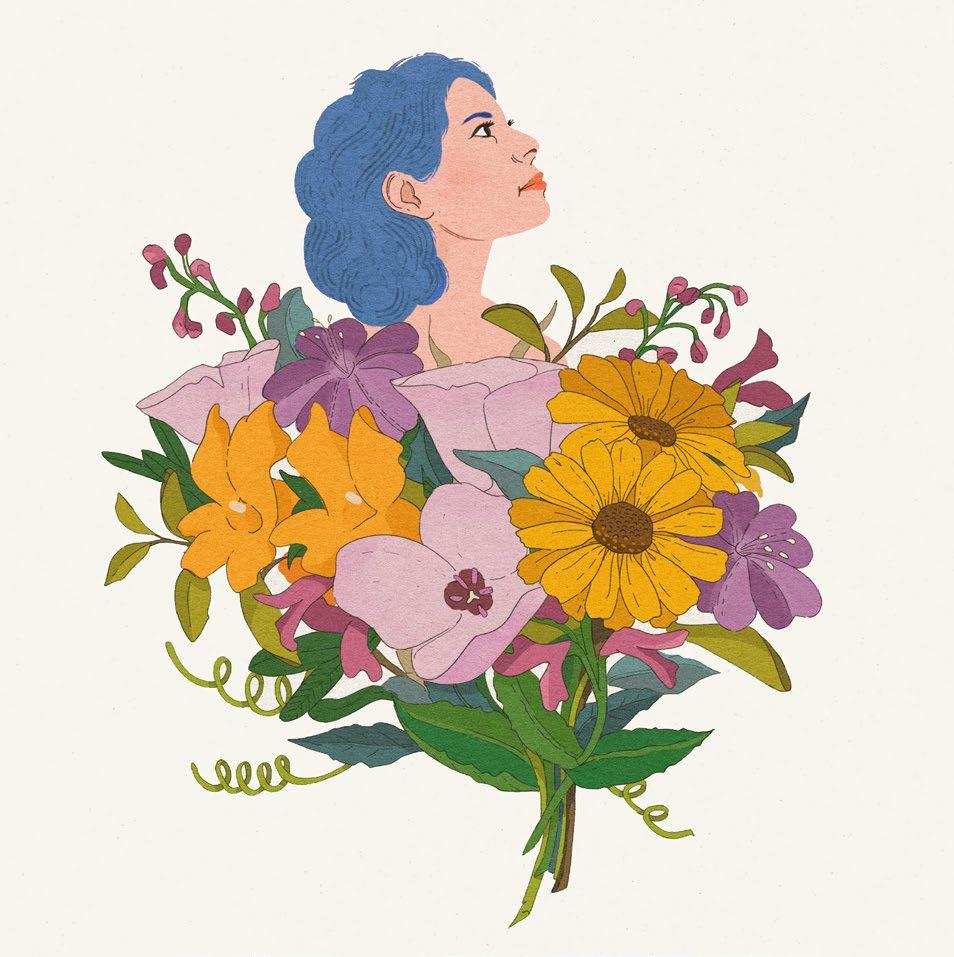
The Summer Solstice has finally arrived and we are ready for it! This special American Flowers Week edition of Slow Flowers Journal is filled with flowers, and design inspiration for parties and interiors, while our botanical couture collection will pique your imagination with unexpected floral fashions.
We also explore the inventive ways that Slow Flowers members use flowers and plants to fill interior spaces – from a recent showcase that festoons the rooms of a Victorian farmhouse at Rose Story Farm, to an empty industrial space in Detroit reimagined by botanical artist Lisa Waud. Tara Folker of Splints & Daisies sets the table with local flowers, and Emily Pek of Frayed Knot Farm shares her essay about important community connections.
To inspire your floral enterprise, we’ve invited Ellen Frost of Local Color Flowers to contribute this issue’s Business of Flowers column, and discover cut-flower insights from the just-released National Gardening Survey, supported by a special partnership with Slow Flowers Society.
As June comes to a close, we’re heading to Alberta, Canada, for the 7th Annual Slow Flowers Summit, our first-ever international gathering at Banff Centre for Arts & Creativity. It promises to deliver education and inspiration, while connecting like-minded floral professionals with one another! Here’s to Summer!
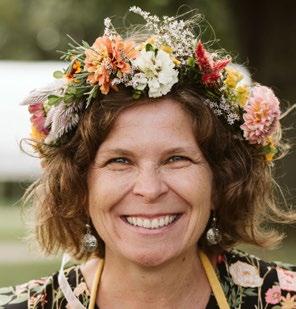
ELLEN FROST Ellen Frost is the owner of Local Color Flowers. She started her floral studio in 2008 to provide Baltimorearea couples with a more sustainable flower option for their celebrations. Over the past 17 years, Ellen has grown Local Color Flowers into a thriving business, adding floral design classes, corporate events, subscriptions, and retail, as well as creative social and educational community events – all using 100 percent locally grown flowers. Ellen is now expanding Local Color Flowers with a free weekly newsletter, YouTube channel, and online community. ellenfrost.com @ellenfrostflowers
LESLEY GOREN. Lesley Goren is an artist and illustrator interested in “place,” be it the woods, the city, or somewhere in between. Lesley creates work depicting the beauty of California's natural environments, as well as informational illustrations explaining plant and fire ecology. Her drawings are contemporary and lively while remaining scientifically accurate. She loves using images and text to make ideas more accessible. Lesley has shown and sold her work in galleries, boutiques, and park visitor centers throughout California and beyond. Lesley resides in Ventura County, California. lesleygoren.com @lesleygoren

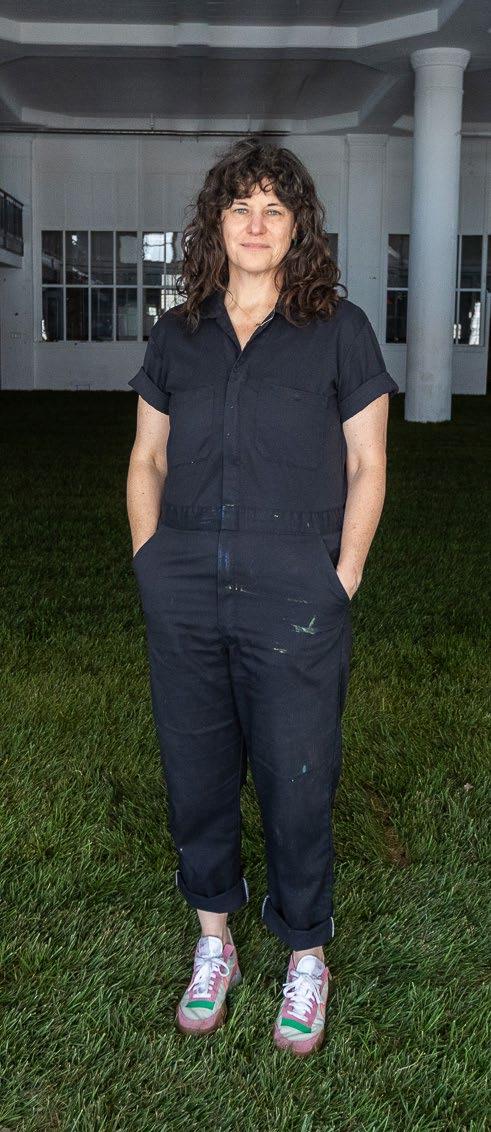
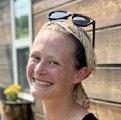
EMILY PEK. Emily Pek’s passion for systems-thinking and agriculture led to an apprenticeship in Brooklyn, New York, in 2016, where she learned how to farm while studying food justice. Upon returning to her deep roots in Cleveland, Ohio, she worked at various farms and started Frayed Knot Farm in 2017. The land that Frayed Knot resides on was previously stewarded by her grandparents, who have been part of the community for close to a century. frayedknotfarm.com @frayedknotfarm
JEN RICH. Jen Rich is the owner of Rich Earth Designs, a small flower farm and floral design business based in Portland, Oregon. She is passionate about creating flower experiences for the community, designing with the beauty that nature provides, and the positive benefits that it has on their wellbeing. richearthdesigns.com @richearthdesigns

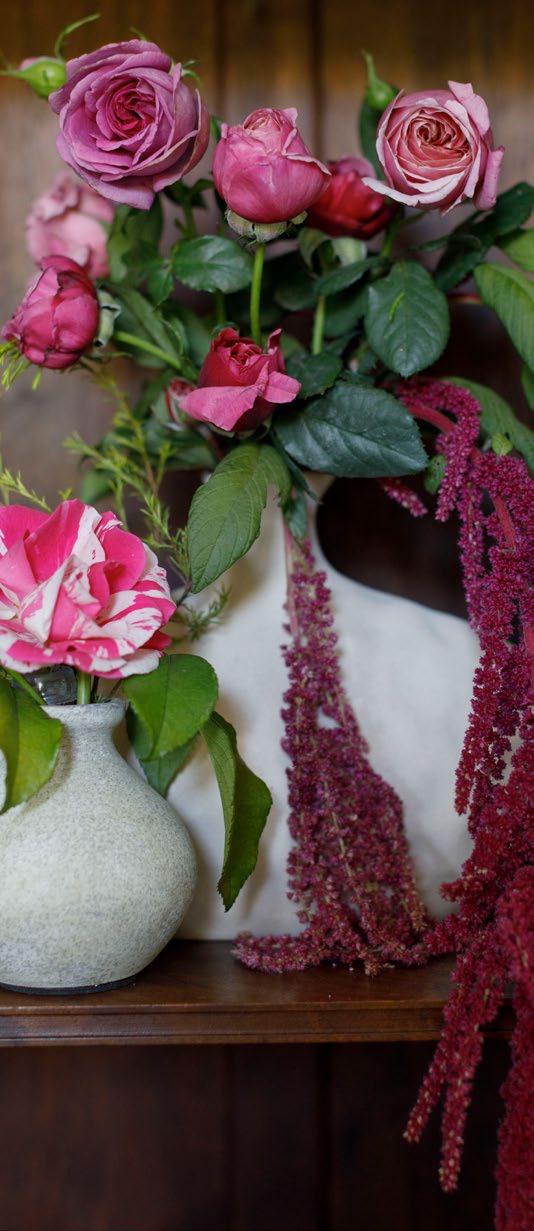


42

6
SITE SPECIFIC lisa waud’s petrichor installation in detroit.
10 FROM THE HEART the future of farming is in community. 16
FLORAL TAKEOVER living with roses. rose story farm opens a Victorian farmhouse to floral displays
20
BOTANICAL COUTURE 2024 coast to coast.
Each look in the American Flowers Week Collection is unique to season and location, elevating flowers and foliage as botanical couture.
GARDEN SURVEY keeping it local. 52
42 THE BUSINESS OF FLOWERS ellen frost. 54
DOWNTOWN BLOOMS bloom tour.
Jen rich helps “flower” her city’s shopping district.
44
2024 AMERICAN FLOWERS WEEK ARTIST lesley goren.
Using wall-to-wall grass, a designer plants an indoor park for the senses
Lisa Waud’s Flower House Detroit was a botanical phenomenon in 2015, when the florist-turned-installationartist turned an empty, aging, early 1900s home into a magical, three-day destination, with the help of 30-plus designers and nearly 40,000 stems of domestic and local flowers. Since then, she has, has continued to redefine the term “florist,” exploring ways to bring art, flowers, and plants into unexpected spaces and to use nature as a cleansing reset.
The founder of pot + box, a former floral studio and shop, Lisa has exhibited site-specific botanical installations at cultural venues and public spaces across the U.S., and at Flora, the international flower festival in Cordoba, Spain. Earlier this year, she moved into the Boyer Campbell Building in Detroit as its first artist in residence. The unoccupied building offered a cavernous, 16,000-squarefoot “blank canvas,” where Lisa has produced three successive installations that explore her creative ideas: Memory Forest (May 3-17); Petrichor (May 31-June 2); and Portrait (June 28-29).
“My history of not only having big ideas—but following through with them—was integral to finding a space where I could work on this scale,” Lisa explained. “But the thing about most of my past projects is that I’ve not been able to prototype ideas.” Like floral event work, planning a botanical installation isn’t always possible. “You’re not often getting paid to do a mockup of an archway or anything larger,” she pointed out.
Spending unrushed moments occupying the Boyer Campbell Building allowed her to build three-dimensional

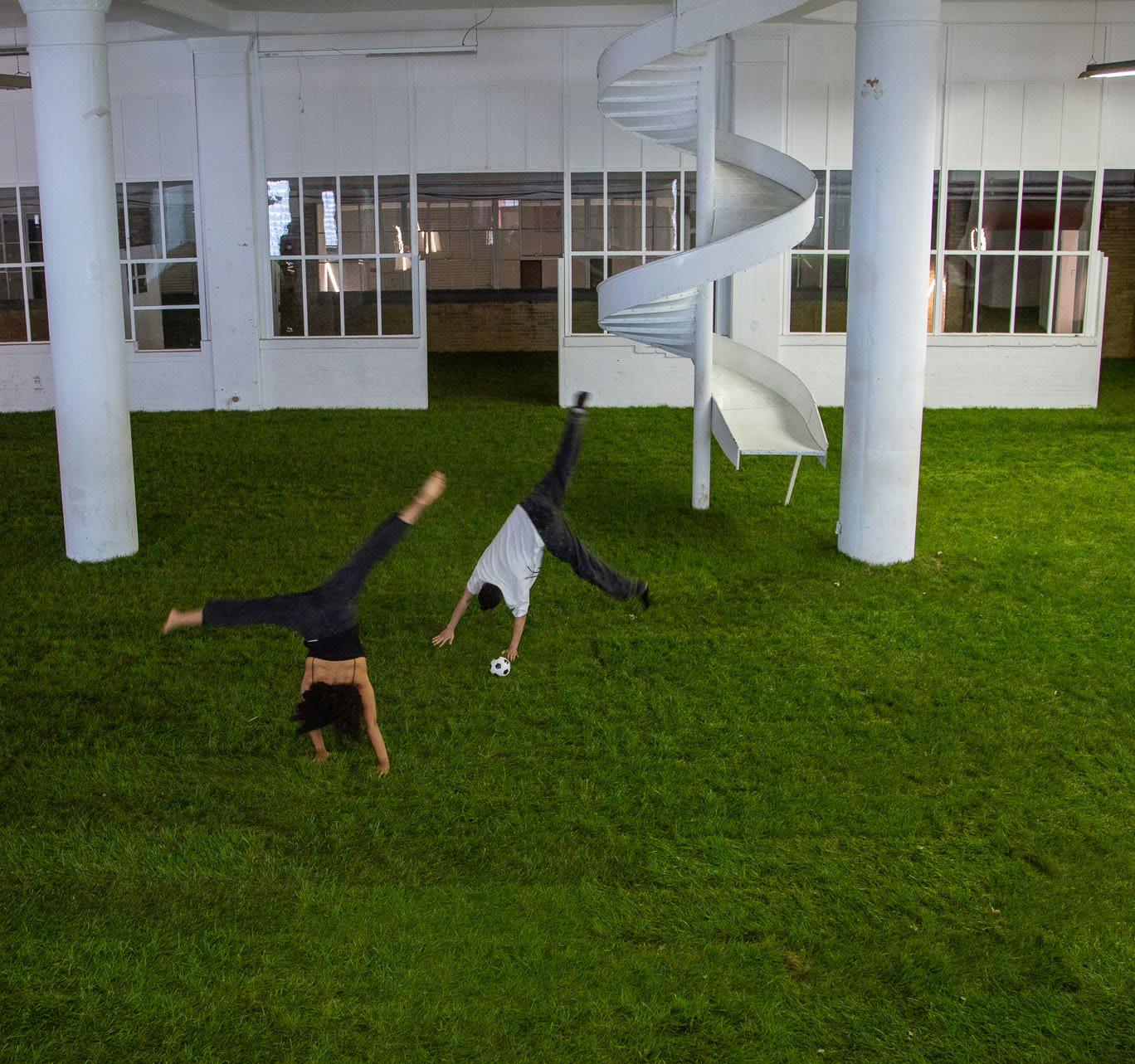

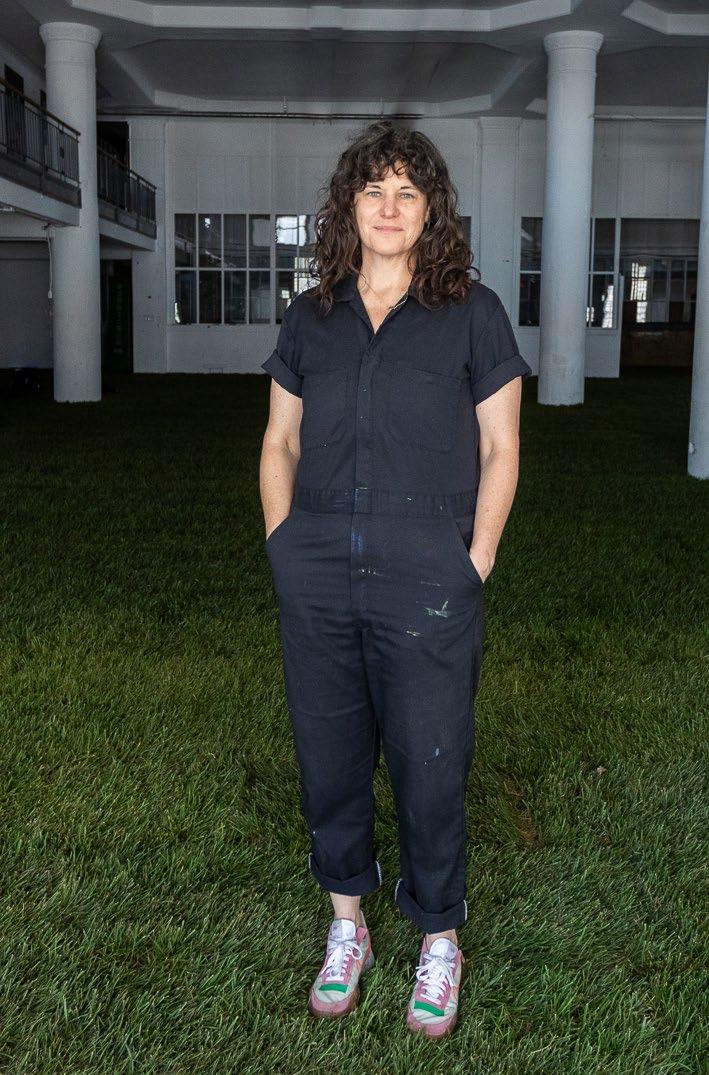
prototypes, understand how light moves through the interior, and imagine how to incorporate the factory floor and loading dock into a botanical experience. It all informed Lisa’s series of public installations. Petrichor, her second exhibition of the residency, brought to life one of Lisa’s longconsidered ideas of carpeting an interior space with traditional sod.
“I first had this vision when my flower shop was in the Fisher Building,” she recalled. Since closing the retail shop 2019, Lisa has worked as a freelance floral artist and project manager. But the idea of unfurling rolls of fresh
sod within the unexpected setting of an interior environment stayed with her. “Petrichor is the word for the earthy scent produced when rain falls on dry soil,” she explained. “Such was the sensory experience of this installation.”
To execute, Lisa knew it was critical to identify a partner with a shared approach to community and collaboration, and she credits Mike Thompson, owner of Hillcrest Sod, and his crew, for supporting her vision. She hired them to “plant” the Boyer Campbell factory floor with green, lush grass, and credits Petrichor’s success to their detailed care and attention.
The installation invited guests to engage with what is typically experienced outdoors in a
(temporary) indoor setting— feeling the sensation of grass beneath their bare feet; inhaling the distinct fragrance of soil and sod; seeing a mind-boggling and massive green expanse; and hearing sounds produced by voices and recordings that emulated industrial noises mixed with rainfall.
“The verdancy of the organic material meets the factory architecture in ways the human eye rarely encounters,” she described in an audio narration of the project.
Guests purchased tickets to spend one hour in the space, and Lisa was fascinated to watch how more than 300 visitors embraced the concept of Petrichor over a


three-day period. “People brought picnics. I saw others playing bocce and soccer, throwing a frisbee, doing a cartwheel—all kinds of fun things!” She partnered with one local instructor to lead a yoga session and another to lead a sound bath experience, but most of the time was unstructured and left to the viewer to choose how to engage with the space. She laughingly tells of a stranger’s Instagram comment: “No thanks. I think I’ll sit outside on the grass for free.”
She added, “What I consistently try to do is put plants or flowers in unexpected places and watch how
people respond. Petrichor didn’t produce normal reactions like, ‘that’s pretty, or this is relaxing, or it’s green and my eyes like it.’ Rather, there were reactions like, ‘whoa, what is going on here?!’”
Mostly, guests told her of memories flooding back from times when they laid on grass as a child. “The smell of grass is very specific,” and that triggered a lot of those memories, she noted.
As with many of her prior projects, Lisa planned for Petrichor’s sustainable deconstruction after the exhibit’s final day. She gave away all of the sod, including to the building’s owner who upgraded the Boyer Campbell Building’s grounds. Excess plastic sheeting
went to the Detroit Black Farmer Land Fund, whose members were happy to use it for greenhouses and solarizing projects.
“Whether it’s leftover flowers going into compost or giving away materials that others can use—that brings me joy!”
WEBSITE INSTAGRAM

A floral showcase fills the rooms of an historic country house with locally grown roses and foraged botanicals
Roses have been on Danielle Dall'Armi Hahn’s mind and in her dreams ever since 1998, when she and her husband, Bill Hahn, planted 1,000 shrubs to establish Rose Story Farm in Carpintaria, California.
At the heart of their 15-acre property in Santa Barbara County stands a circa-1880 Victorian country house, a majestic structure where Dani and Bill raised their sons and spent considerable sweat equity restoring each room to its original character. Constructed of solid redwood and oak, with soaring, 11-foot ceilings, the sevenbedroom residence is often used for photo shoots, corporate retreats, and short-term rentals.
In short, the 19th century residence is a dream setting worthy of
ROSE STORY FARM Carpinteria, California rosestoryfarm.com @rosestoryfarm
READ “The Color of Roses” by Danielle Dall'Armi Hahn
A unique photographic collection of 300 stunning roses that spans the full spectrum of the flower’s shades and hues.
GET A SIGNED COPY
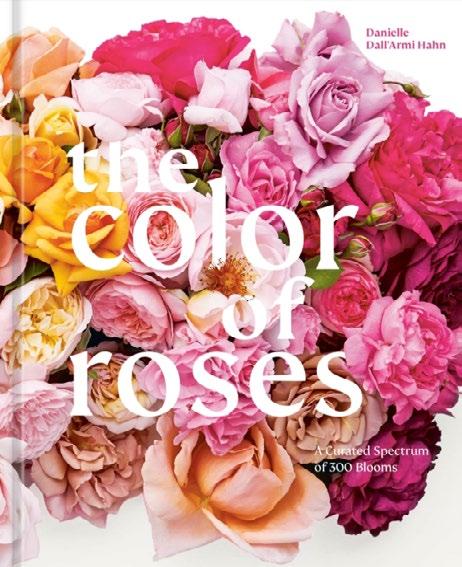

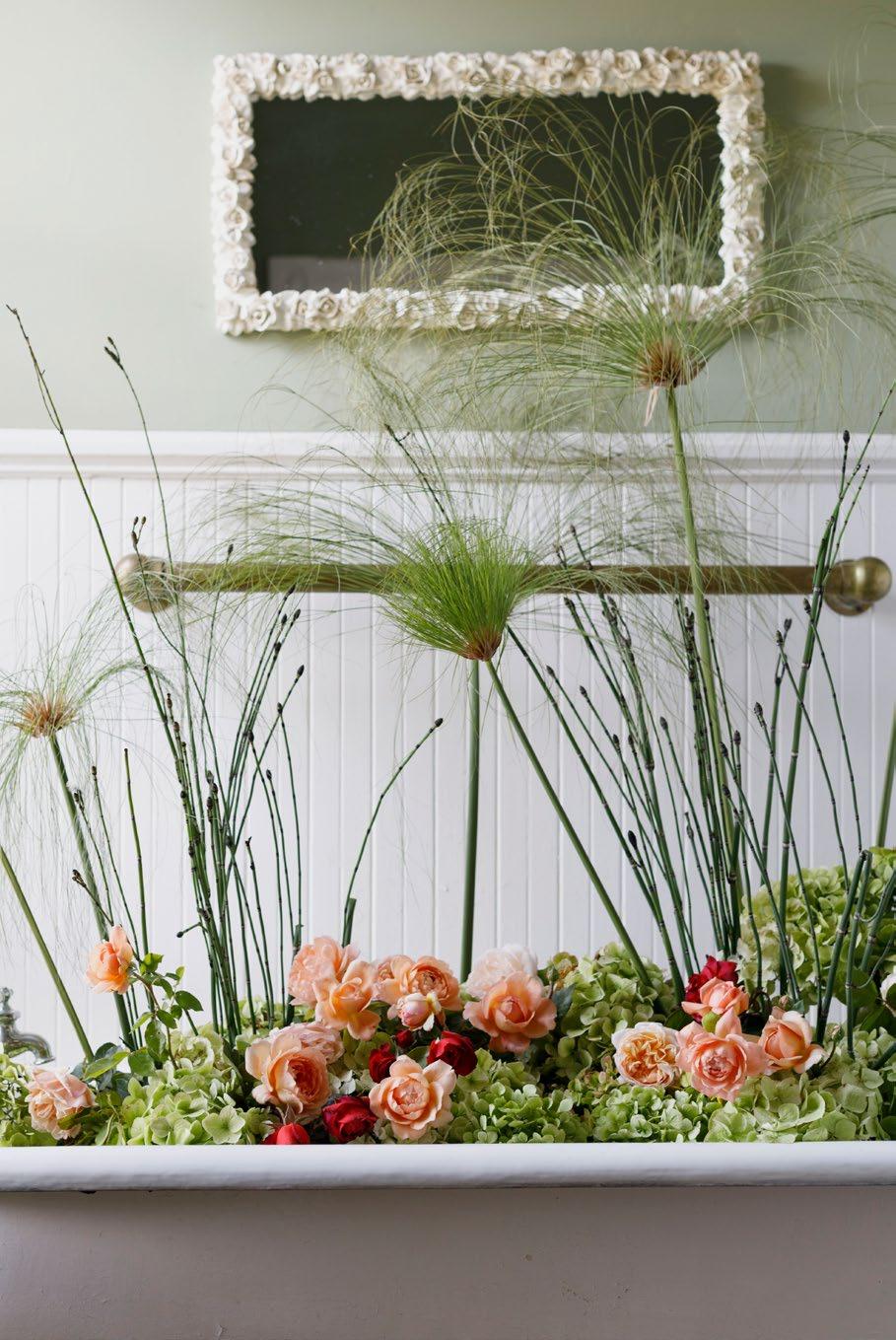
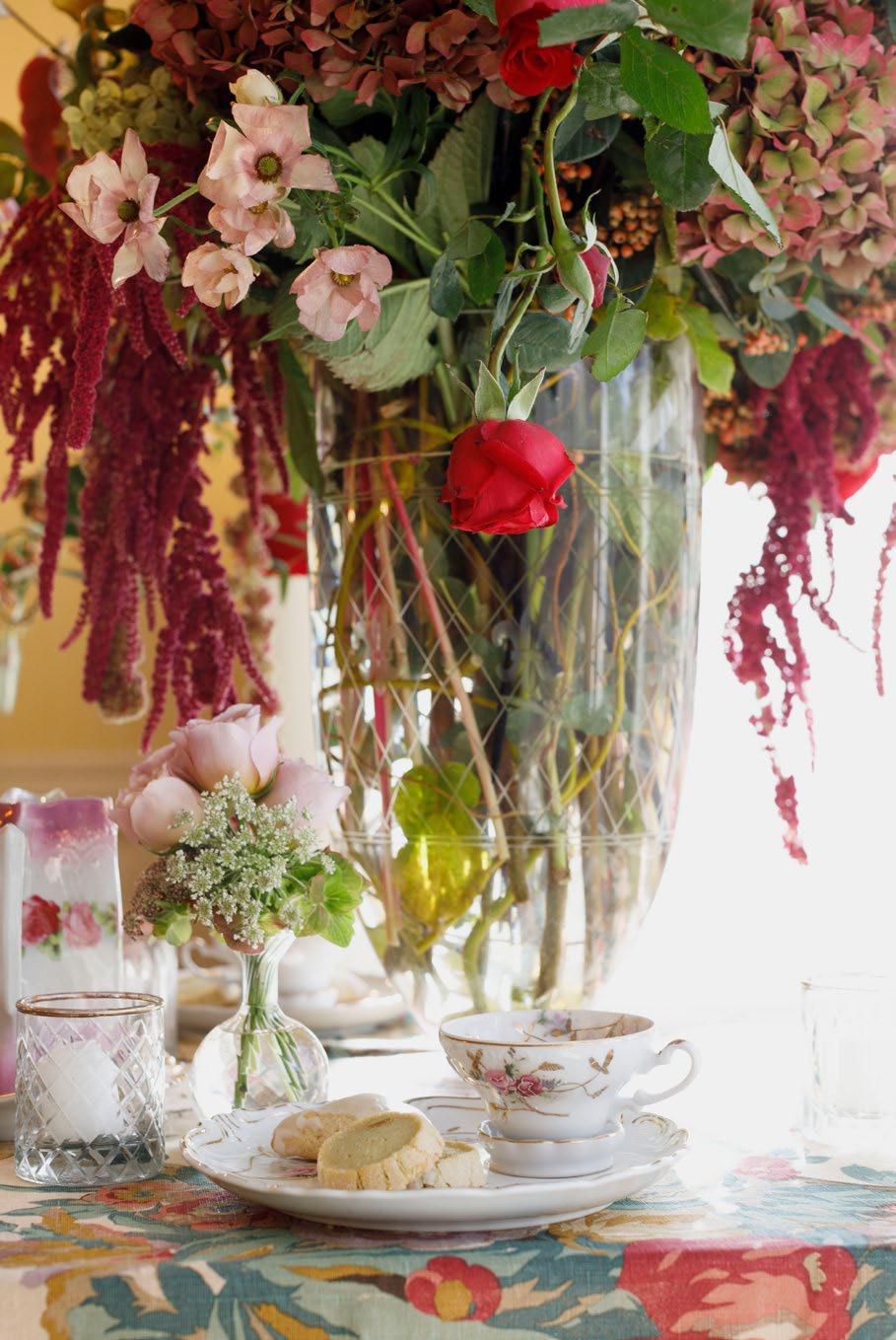

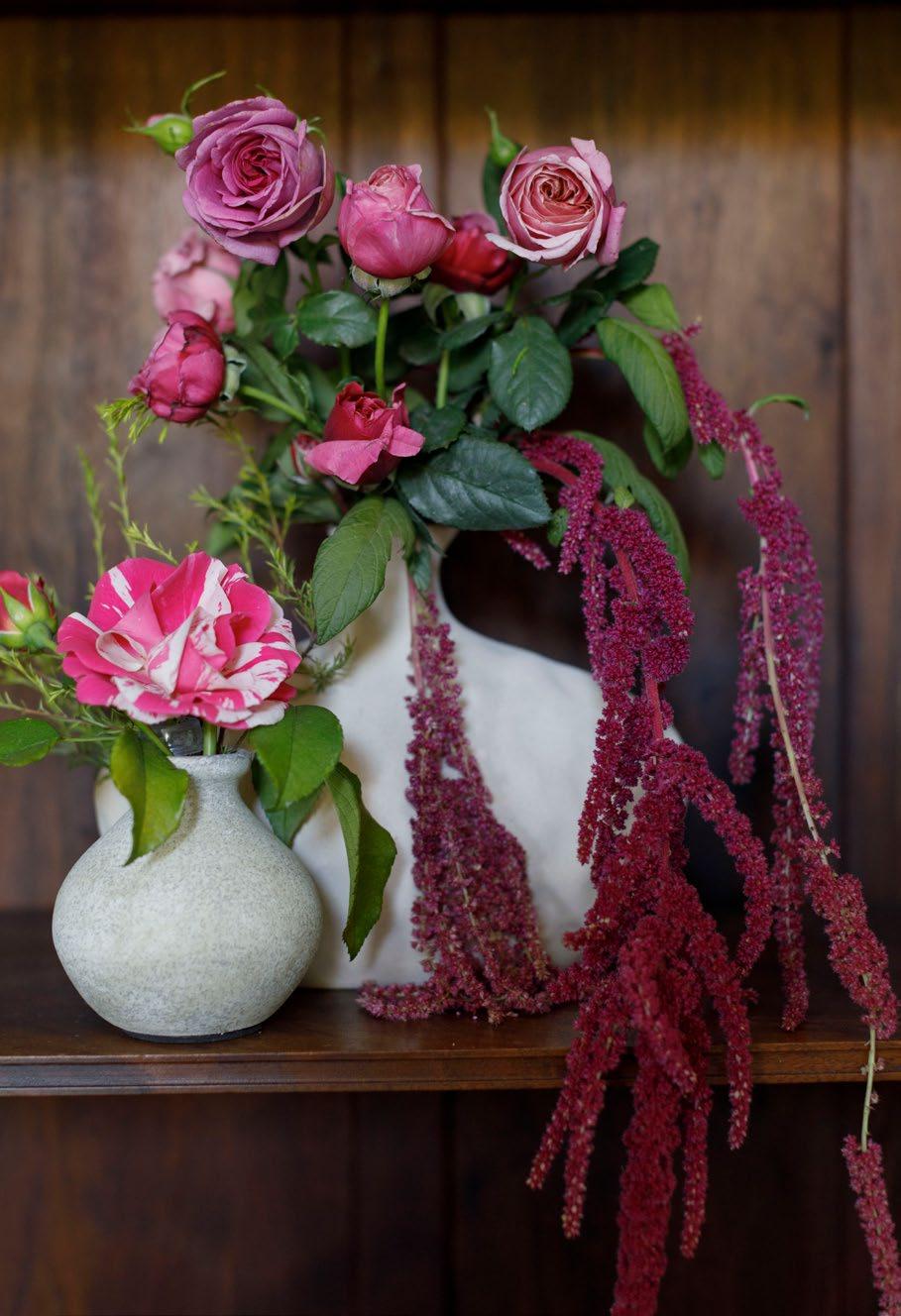
Rose Story Farm’s stunning collection of heirloom and antique garden roses. Last fall, Dani and her team reimagined the historic edifice as the perfect setting for large-scale installations that festooned grand and humble interior spaces with fresh flowers, fruits, vines, branches, and fruit.
“The original idea was to host a design showcase and ask a few of our local designers to each decorate a room. We planned on inviting a photographer to capture the spaces,” Dani explained. “But as more people found out about our plans, many others jumped on board and asked to participate. We ended up with 20 designers, including those local to the Santa Barbara area, and a few from further away – San Francisco, Los Angeles, and Ojai.”
In addition to choosing from a mind-boggling selection of garden roses to inspire their displays (Rose Story Farm grows more than 20,000 fragrant rose plants of 250 varieties, which bloom from April through December), the designers were given an unprecedented chance to “forage” throughout the gardens and grounds.
“We pre-cut roses for everyone, but mostly, the designers went around the farm with their clippers,” Dani laughed. “Some people were cutting fruits – citrus and even avocados. They cut everything!”
The designers had several days to gather ingredients and complete the floral installation in their assigned room. They wrapped up on a Friday afternoon in time for a private evening event to benefit the capital campaign for Casa Del Herrero, a historic house museum and botanical garden. About 100 patrons toured the flower-filled rooms as they met the designers, savored refreshments, and enjoyed musical performances given by Dani and Bill Hahn’s son and daughter-in-law, professional opera singers.
For each designer, the rare chance to work without limits or client constraints allowed them to express their floral art with endless creativity. They also composed a narrative for their installations, adding to the storybook atmosphere and weaving a tale of each
OUTDOOR ENTRY WAY, GLASS TABLE Casa Floral Team (Jane Defnet, Diane Sassen, Cathy Clemens, and Gina Jannotta)
KITCHEN; Your Creative Light Designs LA (Michelle Selko-Cohen and Michelle Sapio)
OUTDOOR TABLES/SECOND HALF OF KITCHEN: Pacwest Blooms (Brian Schnieder)
DINING ROOM: Emma Rose Floral
PIANO ROOM: Bright Floral (Amy Pihlar) / Haute Blossoms Floral (Becky Knieriem)
BAY WINDOW SITTING ROOM: SR Hogue (Jerry Peddicord and Kristi Meland)
GREEN ENTRY WAY: Nicole Chapman Design (Nicole Chapman)
LIBRARY: Jenn Sanchez Design (Jenn Sanchez)
POWDER ROOM: Camellia Floral and Landscape Designs (Camille Grizwald)
ENTRY WAY ARRANGEMENTS: The Garden Club of Santa Barbara (Cheryl Miller and Pat Tenney)
OUTDOOR TABLE ARRANGEMENTS: Rose Story Farm (Claudio Cervantes)
UPSTAIRS: MASTER BEDROOM: Holly Flora (Holly Vesecky)
HER BATHROOM: Ojala Floral (Ashley Morgan)
DRESSING ROOM: Wendy Foster (Teresa Strong)
GUEST BEDROOM/ BATHROOM: Coco Rose Design (Nina Kincaid)
BOYS’ BEDROOM #1 + PORCH: Toast Santa Barbara (Kim Curtis)
BOYS’ BATHROOM: Emma Rose Floral (Emma Lauter)
BOYS’ BEDROOM #2: Breanna Jane Botanicals (Breanna Burgess)

room’s imaginary occupants, Dani added. “Everybody got encouraged by seeing one another’s work. You really had to look at each room carefully or you’d miss the details as the stories came to life.”
The farm has been asked if their design showcase will be repeated, but Dani said it was a one-time-only event. “We may invite florists to create installations at another location in the future,” she conceded, noting the farm’s many cottages, barns, and courtyards – all of which are potential settings for a floral takeover.
For a quarter-century, Rose Story Farm has enjoyed relationships with clients, florists, and wedding and event designers who value the fragrances, forms, and petal colors of the ephemeral rose varieties grown there. For Dani, watching florists transform the Victorian residence into an old-world setting to showcase her roses was an incredible experience.
“I can’t forget what one designer said to me,” she recalled. “She said, ‘We loved being able to do want we wanted to do. We had no clients telling us what color they wanted or what style they wanted. This is us. This is our creation.’
FLOWERS
Otto and Sons Nursery Florabundance
PHOTOGRAPHY
Studio Arna – Arna Behar
FOOD AND WINE
Samsara Wine
Loria Stern, Eat Your Flowers (floral cookies)
Patricia Dall’Armi (lemon cakes and biscotti)
Cheryl Miller (cookies)
MUSIC
Geoffrey Hahn and Dorothy Gal, vocalists
Bridget Hough, piano

The average lifespan of a farm is often reported as five years. I’m nearing one decade of farming and as I get closer to that milestone, it comes with a tremendous amount of reflection.
What I’ve learned again and again is that cultivating community is not only beneficial but absolutely essential to this work. Farming cannot be done alone. This is not a new or original concept, but I will shout it from the mountain tops as long as I’m able to farm. This is our lived experience at our threeacre flower farm in rural northeast Ohio.
If you have a choice in farming as a career (as a reminder, many do not), the first few years are run on passion and adrenaline. Witnessing the alchemy of a microscopic seed turn into a multilayered bloom is something to behold. It's that unmatched high that keeps you going. You get to bring magic into this world and, even better, share it with others.
Then, you face the inevitable setbacks. Relying on income from a perishable, living product in a rapidly changing climate is not the most logical (or lucrative) choice as a career. I feel that I owe it to anyone willing to listen to be honest about what this truly means. While I indeed love what I do, love alone doesn’t make up for the literal back-breaking work, or the emotional and financial toll required to face insurmountable challenges day in and day out. As a consumer or aspiring farmer, it's so easy to be enchanted by the fantasy that Instagram paints. As a farmer, it's so easy to ignore your impending burnout because of it. Flowers are especially effective in this illusion. Their beauty allures, and it's hard to imagine that something so delicate can also be so rough behind the scenes.
It can be isolating to feel the pressure of doing it all while also presenting flower farming as though it’s effortless. I quickly learned that going at it alone in this work is wholly unsustainable.
This sentiment came into focus in Frayed Knot Farm’s first season, when a dear friend asked me to grow flowers for her wedding. It catalyzed the business, and began a journey toward building relationships with our larger community and creating a community of our own. Unsurprisingly, I experienced a few crop failures and slower bloom times for that first wedding commitment, and because of it, started to reach out to other local farmers for support. It was the first step in understanding that “connection” is the most important tool I had.
In subsequent years, with every struggle, there was an abundance of community seemingly waiting to be brought into this venture. Struggles turned to successes and it became easier to form collaborations as a prevention to future challenges. It’s now a part of every aspect of the farm, from soil to sales.


Shortly after moving back to my hometown of Cleveland, Ohio, where I started Frayed Knot Farm, I was introduced to a group of scrappy young men (Rust Belt Riders and Tilth Soil) who were a few years into a food scrap-hauling and compost business. Today, their efforts have grown into a thriving worker-owned cooperative with a crew of 30. If you’re a grower, you know the value of good compost! One of the co-founders and worker-owners is now also my husband, so we have a true closedloop, full-circle family.
A chance encounter at a local business meet-up led me to Jess Boeke and Sarah Pottle, founders of Rust Belt Fibershed. We bonded over our shared dedication to creating more regenerative systems. Before I knew it, we were laying yards of compost
down from said scrappy men and planting flax with dozens of community members, with the goal of understanding where our clothing comes from. Flax is the crop that linen is made from, and it also makes beautiful dried arrangements!
When contemplating sales outlets in those early years, I had the great fortune of meeting Jennie Doran and Andrew Worm of Room Service Boutique, local shopkeepers and huge advocates for everything we were doing. They graciously took a chance on a new farmer by helping to launch our CSA Bouquet Subscription service, hosted at their retail space. We’ve since done multiple yearly partnerships and celebrated the fifth year of our CSA program in 2023. The program also evolved to include a partnership with a beloved Cleveland staple,
Ohio City Farm, which offer flowers as an add-on to their robust vegetable share.
You never know where your networking will lead. An interaction today could quite literally be planting the seed for something to come years later. What is officially called “The Collab” started as a handful of northeast-Ohio growers looking to share information about flower farming in the off-season. We now aggregate our collective product and sell wholesale to local florists. The organization has grown exponentially, fervently trying to meet the demand for locally grown flowers. It has proven to not only support our community of buyers, but also one another. Farmers are our number one customer and our group acts as a safety net for the predictable unpredictability.
Frayed Knot Farm started as a lot of singular dreams – and those dreams intertwined with others. While we were developing relationships outside the farm we were also cultivating an interpersonal ecosystem of our own. Jules Handley and Lexie St. Denis round out our unstoppable crew and are a critical part of dayto-day operations. Along with Zoe Apisdorf, Jules helps to manage stewardship of the farmland and each has plots of their own at our farm. I know for a fact that Frayed Knot would not have made it this far without them or have been nearly as fulfilling.
Farming is not easy and rarely, if ever, glamorous. It continues to be more difficult as the years go by and the future of this work remains uncertain. It’s also an incredibly hopeful endeavor and one that I’m so proud to be a part of. As the seasons change, you learn to adapt. Strength is built in numbers and in community.
Emily Pek’s passion for systems thinking and agriculture led to an apprenticeship in Brooklyn, New York, in 2016, where she learned how to farm while studying food justice. Upon returning to her deep roots in Cleveland, Ohio, she worked at various farms and started Frayed Knot in 2017. The land that Frayed Knot resides on was previously stewarded by her grandparents, who have been part of the community for close to a century.
WEBSITE INSTAGRAM


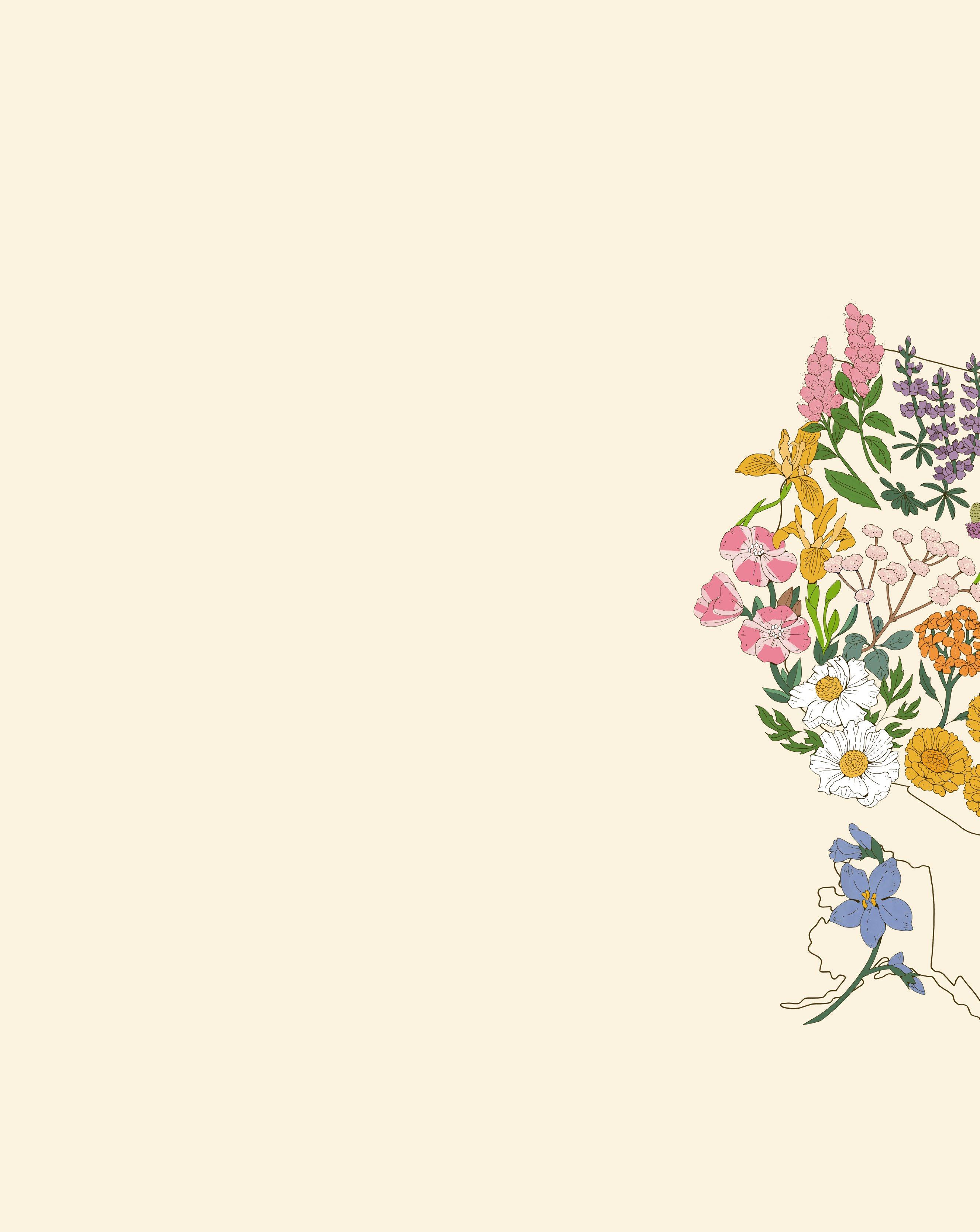
American Flowers Week’s 10th Anniversary
American Flowers Week encourages flower farmers, floral designers, flower enthusiasts, and gardeners alike to promote their blooms across social media with the hashtag #americanflowersweek. The campaign debuted in 2015 and has continued for a full decade as the original domestic flower promotion holiday.
The relevance and importance of local, seasonal, and sustainably grown flowers continues to influence the professional floral marketplace, as well as passionate consumers. By designating a single week to our promotion, Slow Flowers Society elevates awareness and highlights the many reasons to support local flowers, and those who grow and design with them.
This year’s American Flowers Week botanical couture collection is unique to the location and season where it was produced and photographed, with design narratives that elevate and reimagine flowers and foliage as botanical couture. Read on to discover five floral fashions that showcase domestic flowers as wearable art.

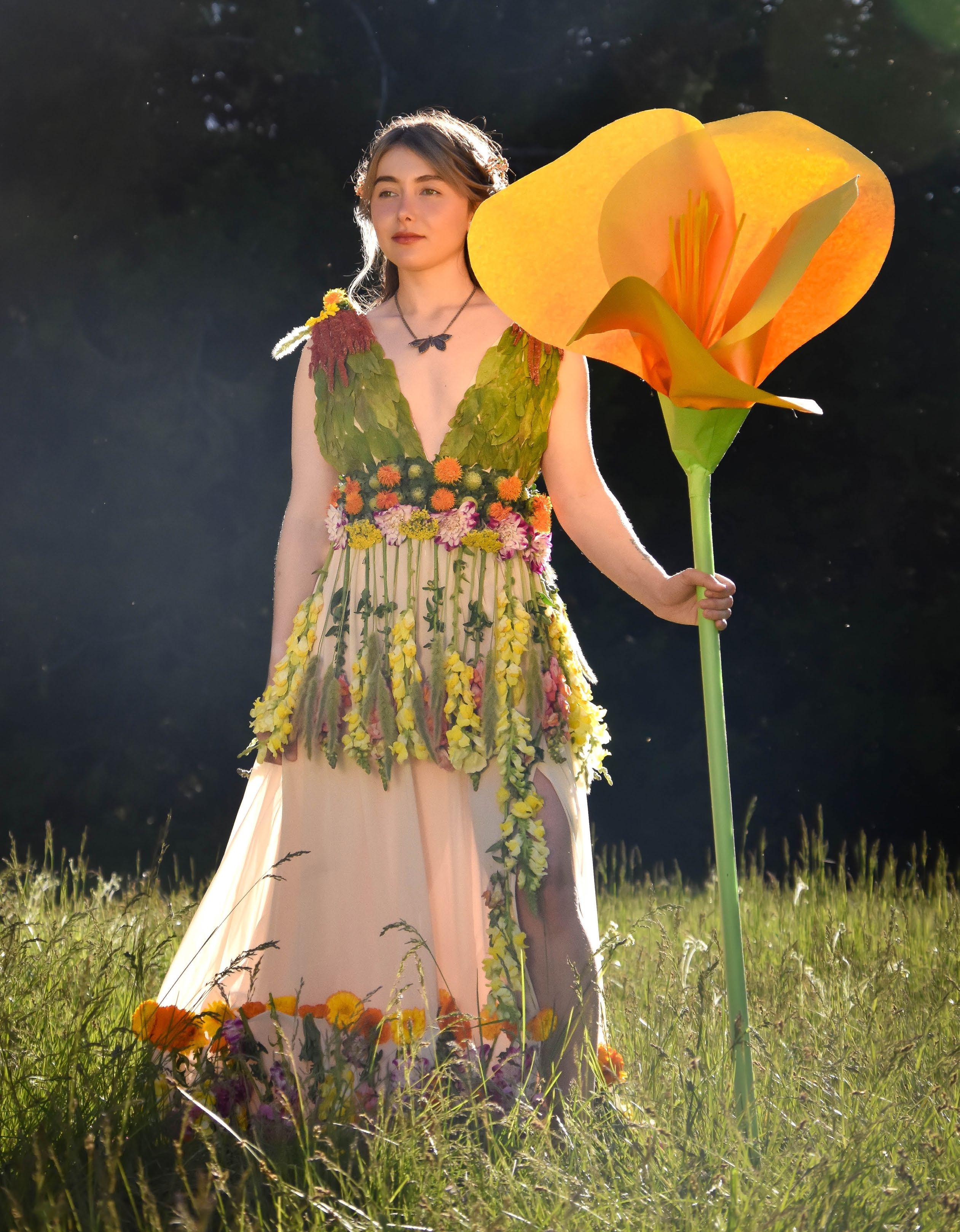
DESIGN + PHOTOGRAPHY BY
JENNY M. DIAZ, PRATHER, CALIFORNIA
THE CALIFORNIA POPPY (ESCHSCHOLZIA CALIFORNICA), ALSO CALLED golden poppy, has long been depicted by illustrators and artisans who work in pottery, stained glass, surface design, and other media. Poppies often appear in the Art Nouveau style of the early 1900s, entwined with graceful curves and natural forms.
Jenny Diaz was inspired by the work of Art Nouveau painter and illustrator, Alphonse Mucha (1860-1939), known for his illustrations of women with flowing hair, diaphanous gowns, and lots of flowers, including poppies. In planning her fourth floral fashion for American Flowers Week, Jenny turned to Mucha’s style, interpreting it for her own.
“His work is whimsical, but feminine and elegant,” Jenny explained. “The vibe I wanted was whimsical, but also playful and ethereal.” You can just imagine her model looking at home in the California of the 1960s—barefoot and carefree.
Jenny is credited with designing many American Flowers Week and Slow Flowers Society projects—including our original AFW logo in 2016 and two popular coloring sheets, including one depicting all 50 state flowers on a
DESIGN + CONCEPT: Jenny M. Diaz, Jenny M. Diaz Design, @jennymdiaz PHOTOGRAPHY: Jenny M. Diaz FLOWER SOURCES: CamFlor Inc., Watsonville, California, camflor.com | @camflorinc MODEL: Kara Trukki, @luckytrukk1 VENUE: Shaver Lake, California
DESIGN + PHOTOGRAPHY BY
JENNY M. DIAZ, PRATHER, CALIFORNIA
map of the U.S., which features the state of California surrounded by poppies, perhaps giving Jenny a Poppy State of Mind for this year’s project.
For the photography location, a meadow near Shaver Lake in the Sierra National Forest, Jenny fashioned a trio of larger-than-life poppy flowers to appear as props. A true maker, she researched how to make giant flowers watching YouTube, picking up all the needed supplies to turn PVC pipe, construction paper, and pipe cleaners into imaginative, oversized blooms. The flowers frame model Kara Trukki, as she portrays a turn-of-the-century woman—straight from Mucha’s canvas.
The green amaranth foliage gives the bodice a pavé surface that extends to the deep V-neckline and a waistband patterned with safflower (in bloom and bud), dahlia heads, and clusters of statice.
The bodice of a long, flowing dress is covered with the foliage and blooms of amaranth, with shoulder details that include safflower, amaranth, bunny tail grass, and other blooms. The green amaranth foliage gives the bodice a pavé surface that extends to the deep V-neckline and a waistband patterned with safflower (in bloom and bud), dahlia heads, and clusters of statice. To emphasize the drape of the gown’s skirt, Jenny layered a delicate tracing of stems and petals as “botanical embroidery,” letting blooms trail downward from the waistline and creating a meadow across the hemline.
The photography echoes Mucha’s preference for pastoral scenes like this one, with a picnic basket and fruit continuing the narrative. It’s a perfect narrative for celebrating California’s iconic state flower.
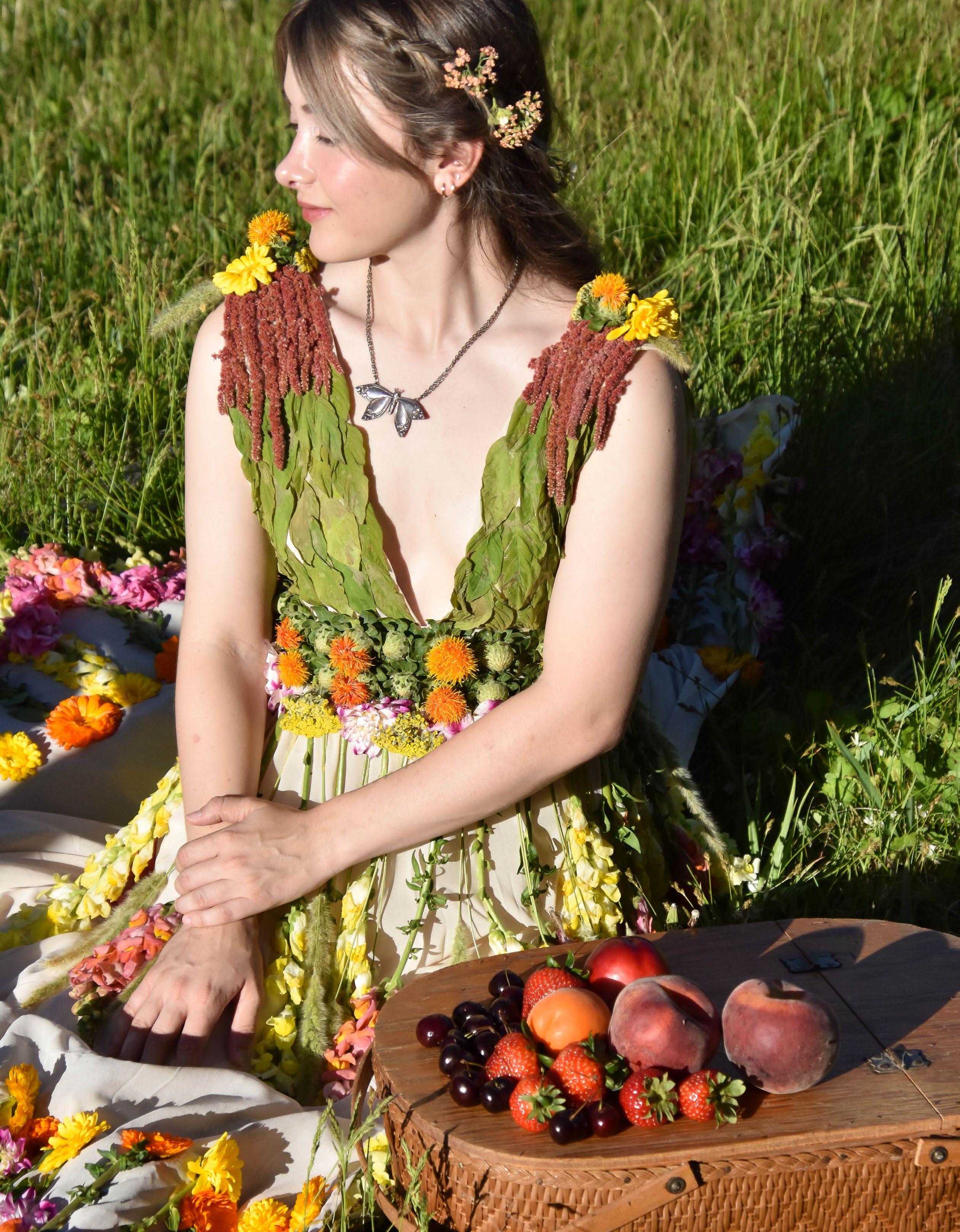
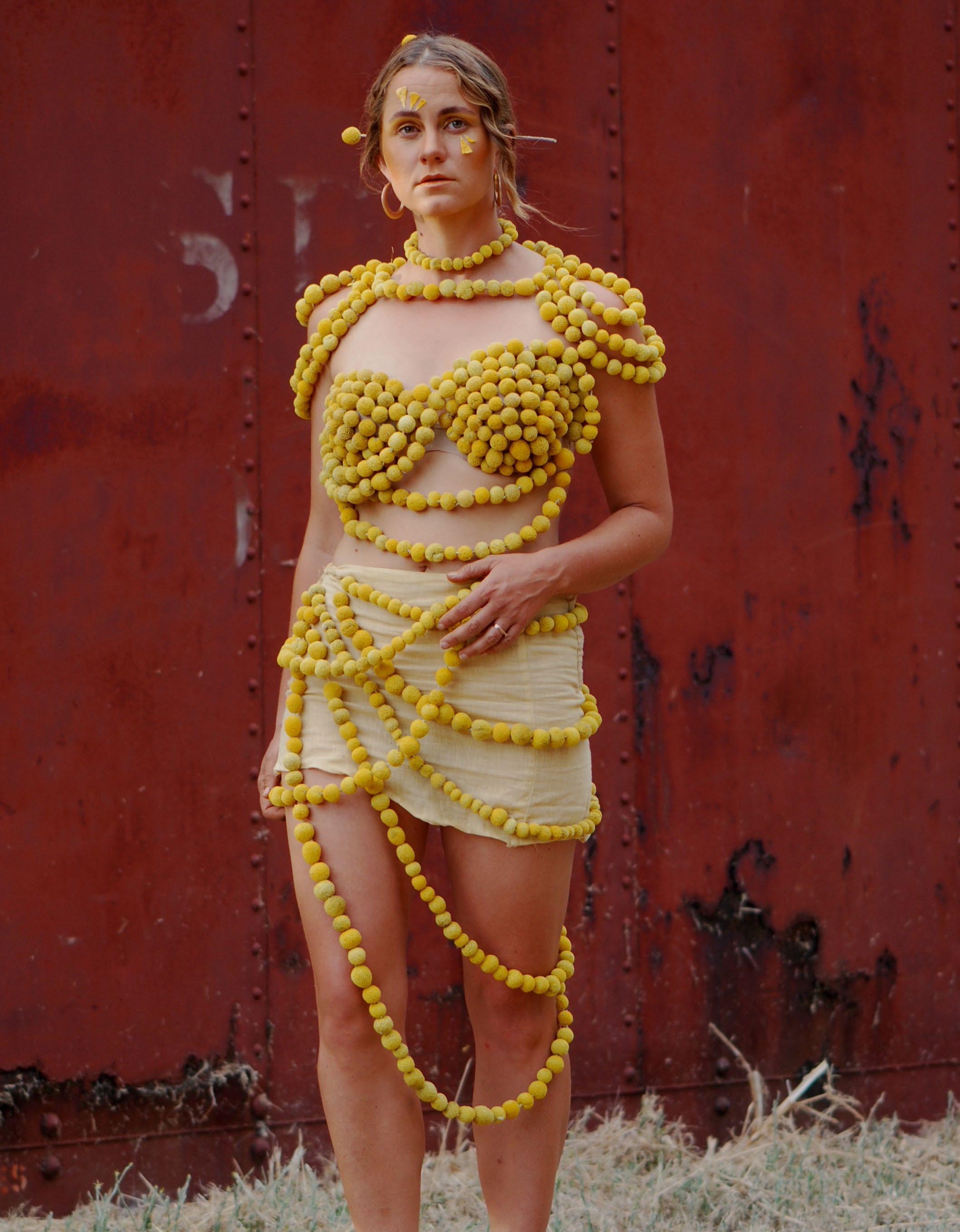
BOTANICAL COUTURE 2024
DESIGN BY HANNAH ROSE RIVERS MULLER, GUINDA, CALIFORNIA
PHOTOGRAPHY BY ELLIOT SCHOENIG
IN HER NEW BOOK,“DESIGNING WITH DRIED FLOWERS” (CLARKSON Potter, 2024), farmer florist Hannah Muller of The Wreath Room and Full Belly Farm shares unique methods to naturally dry flowers that hold their color and delicacy. Her book teaches readers how to design small arrangements for every day, wreaths for all seasons, and celebration showstoppers that will look gorgeous in the moment and for months to come.
Hannah calls one of her favorite projects in the book “Billy Button Strands,” which elevates the spherical Craspedia globosa, a tender perennial from Australia that produces one-inch-sized “flowers” that resemble tiny gumdrops. This flower offers the ideal jumping-off point for home décor.
Yes, these flowers can be used in vase arrangements, but when the stems are removed, they can be threaded onto strands for garlands and strands, she said.
“Their spherical shape and cheerful yellow color make them modern and perfect for small, simple designs.”
In the book, Hannah demonstrates using a needle with clear fishing line to
DESIGN + CONCEPT: Hannah Muller, Full Belly Farm, @wreathroom, @farmerhands
PHOTOGRAPHY: Elliot Schoenig FLOWER SOURCES: Full Belly Farm, @full_belly_farm
MODEL: Hannah Muller
VENUE: Full Belly Farm, Guinda, California
BOTANICAL COUTURE 2024
DESIGN BY HANNAH ROSE RIVERS MULLER, GUINDA, CALIFORNIA
PHOTOGRAPHY BY
ELLIOT SCHOENIG
make craspedia strands. For her garment, she opted to use gold bullion wire as “thread.” She explained, “That’s how I got a little bit more shape to the design, because the wire helps to keep the bodice pieces in place.”
Turning festive strands of flower heads into a wearable garment took some creative engineering. Designed, fabricated, and modeled by Hannah, the golden dress takes its inspiration from an extravagant Schiaparelli gown made from strands of 50,000 pearls, which celebrity Kim Kardashian wore to the 2023 Met Gala.
“Instead of dressing up in strands of pearls, I created the floral version of her look with strands of Billy buttons,” Hannah laughed.
Threaded lengths of craspedia drape around Hannah’s neck and shoulders; they encircle her waist and cascade from her hips; and as spirals, they form dramatic bust detailing.
“I just loved the idea of taking something dried and making it wearable,” she continued. “This flower is so small, you might not consider it a great option for a botanical outfit, but I really love the intricacy of their size in this design.”
A gradation of yellow hues adds interest to Hannah’s garment. Varying shades can occur in craspedia blooms, depending on harvest stage and whether they have begun to dry, she noted, adding that it’s easier to thread a needle when working with fresh product.
Hannah tapped her husband Elliot Schoenig, a botanist who often photographs nature subjects, to capture the finished look on camera. Her styling adds just the right amount of whimsy, with the addition of ranunculus “lashes” on her face, cheeky sunglasses—and an image of her blowing a huge bubble from yellow chewing gum.
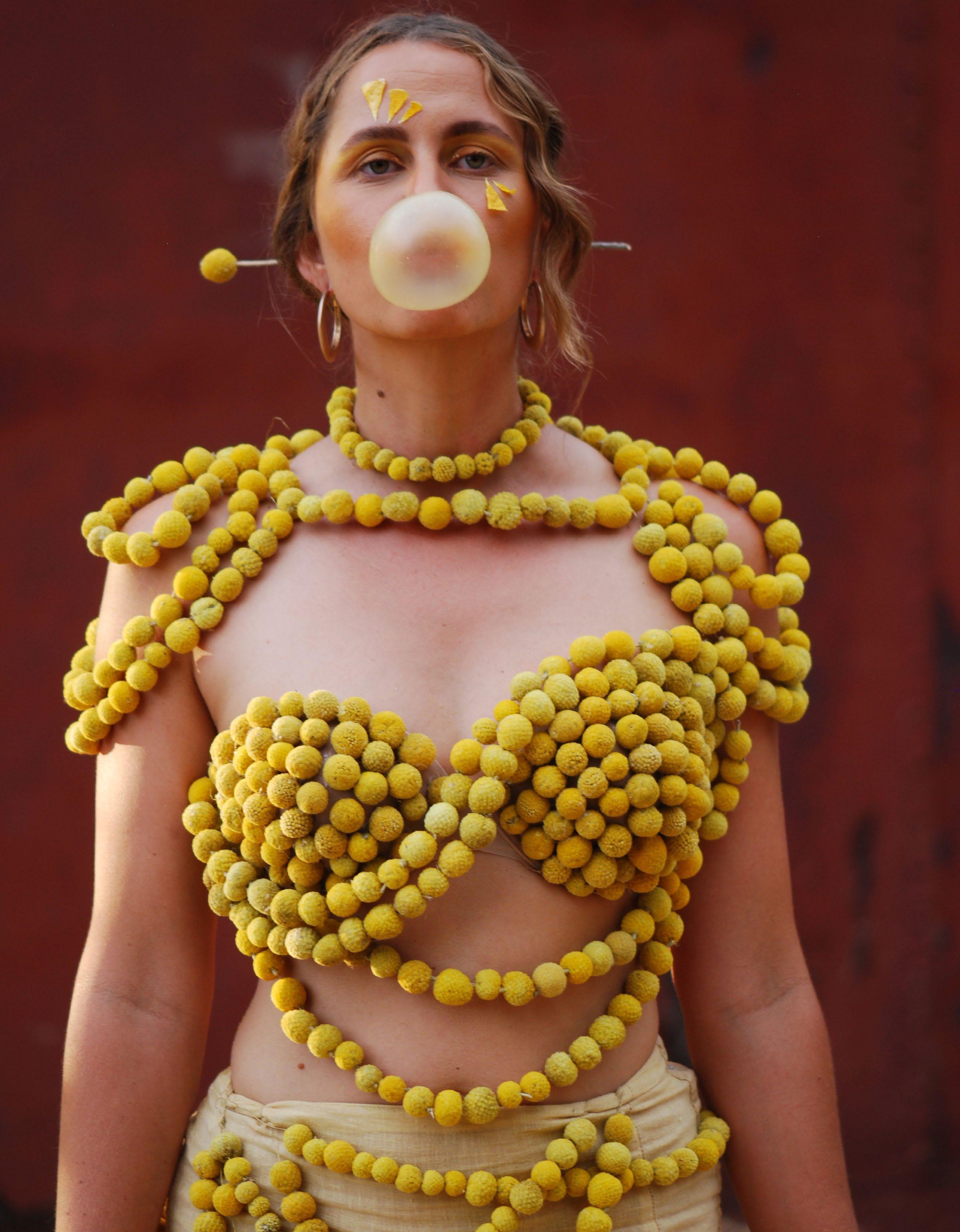
BOTANICAL COUTURE 2024
DESIGN BY ALANNA MESSNER-SCHOLL, WAVERLY FLOWER, WAVERLY FLOWER CO., SCHWENKSVILLE, PENNSYLVANIA
PHOTOGRAPHY BY ASHLEY MEIER
LAST SUMMER, ALANNA MESSNER-SCHOLL EXPRESSED HER FASHIONISTA talents in an Instagram post featuring a feminine and ferny party frock on a dressmaker’s form, photographed in the garden. Of course, we reached out to learn more and discovered that the Pennsylvania-based farmer florist once studied at the Fashion Institute of Technology in New York City.
Experience in fashion, plus a subsequent career in healthcare, led to Alanna eventually establishing a flower farm called Waverly Flower Co. After finishing her post-doctoral fellowship, Alanna stepped back from the healthcare industry during the height of COVID to focus on raising her two children, now toddlers.
Today, Alanna has expanded Waverly Flower Co. into a bustling wedding and events studio with 32 weddings on the books for 2024. Alanna’s most recent creation for American Flowers Week transforms greenery and blooms into botanical couture worn by a human model.
The endeavor drew inspiration from her muse, model Lindsey Gerstlauer, a floral designer who frequently freelances for Waverly Flower Co., and the photography venue, Life’s Patina at Willowbrook Farm, the historic farm
DESIGN + CONCEPT: Alanna Messner-Scholl, Waverly Flower Co., waverlyflowerco.com, @waverlyflowerco PHOTOGRAPHY: Ashley Meier, ashleymeierphotography.com, @ashleymeier26
FLOWER SOURCES: Waverly Flower Co., Schwenksville, Pennsylvania
MODELS: Lindsey Gerstlauer, @lindseygerstlauer
VENUE: : Life’s Patina at Willowbrook Farm, lifespatina.com, @lifes.patina_willowbrookfarm
MAKEUP: Ashley Novak, Glam on Demand, @glamondemand VINTAGE CAR: Little Figgie, @littlefiggie
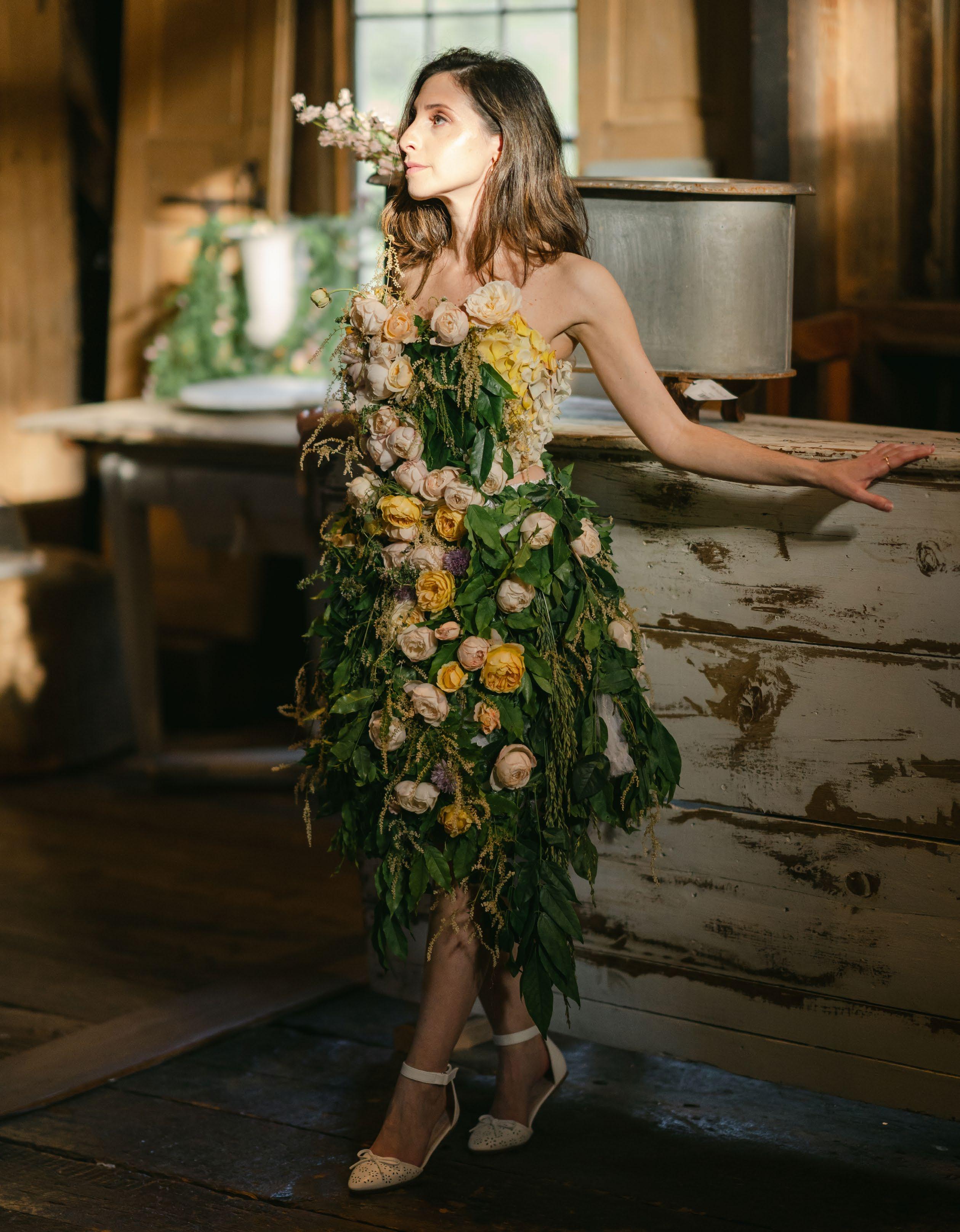

DESIGN BY ALANNA MESSNER-SCHOLL, WAVERLY FLOWER, WAVERLY FLOWER CO., SCHWENKSVILLE, PENNSYLVANIA
PHOTOGRAPHY BY ASHLEY
MEIER
where Ashley Meier photographed the finished look. The Farm is one of Alanna’s favorite local event venues and the landscape, old-world stone barn, garden paths, arbors, and rustic fencing provided character as a setting.
Past and Present features a lush, two-piece garment—a fitted bodice and a petticoat skirt. The design is based on a layer of greenery to which roses and other flowers are added. With an uneven hemline falling just below the knee, the tea-length gown is admittedly foliage-heavy, which is what Alanna wanted.
“To me, ‘garden-inspired’ also means a healthy proportion of greens, because that’s typically what we see in the garden,” she said, adding that she sourced entirely from her garden and flower fields.
Knowing that large quantities of foliage would be required to cover the skirt and top, she trialed 30 different leaf types to determine the best varieties to last out of water for several hours.
“The vast majority did not hold well or retain their shapes,” she noted. “I was open-minded in the sense that I didn’t have to have particularly long stems, but the greenery choices were limited.” She found that the best options were magnolia, pieris, and wisteria foliage, and together, a cascade of these elements provided dimension and detail for the flirty skirt. Alanna wired the leaves to an overskirt made from soft window screening (the type that comes on a roll at the hardware store), which draped over the fabric petticoat.
A proliferation of garden roses, harvested at their peak, frames the neckline, crossing the torso to the hemline in a diagonal arrangement. ‘Desdemona’, ‘Earth Angel’, and ‘Wollerton Old Hall’ roses are accented by creamy white blooms of goatsbeard (Aruncus dioicus) and allium flowers.
To continue her narrative, Alanna procured the use of a stylish roadster called “Little Figgie.” The car is often rented for weddings and events, appearing at prior Life’s Patina events as well. Manufactured as a retro concept car by Nissan in 1991, the Figaro model is now a favorite of collectors. Alanna considered the cool blue-gray hue a perfect match for her blue-eyed model.
BOTANICAL COUTURE 2024
DESIGN BY NIESHA BLANCAS, FETCHING SOCIAL MEDIA, FRESNO, CALIFORNIA
PHOTOGRAPHY BY ANA QUINATA
NIESHA BLANCAS HAS BEEN AN ESSENTIAL PARTNER IN THE PROMOTION of American Flowers Week since our early days. Beginning in 2021, she joined the ranks of creators whose botanical couture looks elevate local and seasonal flowers with avante-garde garments that have told narratives ranging from 1990s pop culture, to the Bridgerton phenomenon, to her family’s MexicanAmerican roots.
“Unwritten,” Niesha’s fifth botanical couture design, is her most personal project yet. This year, not only does Niesha get in front of the camera as the garment’s model, she uses the medium of flowers to tell a personal story of healing.
Her ensemble includes a bralette, a tailored jacket, and high-waisted pants, fully cloaked in vivid green foliage with accents in red, pink, purple, lavender, and blue flowers. She continues earlier themes, including opera gloves as her preferred fashion accessory, with the addition of a floral pillbox hat. Leaves from spotted laurel (Aucuba japonica), have factored prominently in the four prior looks Niesha has designed. But this year, when she visited CamFlor Inc., in Watsonville, California, to select her botanical ingredients, she was unable to find Aucuba.
@
DESIGN + CONCEPT: Niesha Blancas, Fetching Social, @fetchingsocial
DESIGN ASSISTANT: Ana Quinata PHOTOGRAPHY + EDITING: Ana Quinata + Niesha Blancas
FLOWER SOURCES: CamFlor Inc., Watsonville, California, camflor.com | @camflorinc
MODEL: Niesha Blancas


DESIGN BY NIESHA BLANCAS, FETCHING SOCIAL MEDIA, FRESNO, CALIFORNIA
PHOTOGRAPHY BY ANA QUINATA
“I have included this leaf every single year, and I couldn’t not have it this year,” she insisted. Fortunately, her mother, Cathy Blancas, found the plant at a local garden center, so Niesha plucked a single gold-flecked leaf and used it as her jacket’s “pocket handkerchief.”
Niesha clipped hundreds of individual pink and green ornamental kale leaves and shiny green Israeli ruscus foliage to attach to her base garments, using florist cold glue to cloak the pants and jacket with overlapping layers of greenery. There’s a pleasing contrast between the rounded kale edges and the pointed ruscus tips, as the varied leaf shapes create a pattern of their own. The foliages cover olive green vintage pants and jacket, which Niesha found months ago on her many thrifting excursions. Any hint of fabric disappears from view because of the predominance of foliage.
Niesha selected a mix of florals for the jacket’s color-blocked details that appear on shoulders, sleeves, and cuffs. Anemone, cornflower, dahlia, delphinium, dianthus, kangaroo paw, statice, pincushion protea, peony, ranunculus, and sweet pea create mini tapestries.
"I have been on a journey of inner healing, and I wanted to put something beautiful out into the world that told my story."
The portrait in which Niesha holds her beloved cat “Rami” (who wears a kitty harness completely covered in botanicals) symbolizes the emotional support that pets can give. “Out of my four little ones, Rami was chosen. Just like his brother cats, he possesses one of the purest of souls and knows his way around a photoshoot just so he can load up on treats,” she jokes.
As she continues her symbolism through the accessories, Niesha expressed another idea with the pillbox hat. Covered completely with botanicals, the hat is a nod to positive mental health.
“The idea is to remind ourselves to focus on the common goal of protecting our peace, maintaining a healthy mind, and always striving to carry beautiful thoughts,” she said.
BOTANICAL COUTURE 2024
DESIGN BY LINDA SPRADLIN, IN THE GARDEN FLOWER FARM, SEVEN MILE, OHIO
PHOTOGRAPHY BY ZACHARY SPRADLIN
productions, flower farmer Linda Spradlin has no shortage of ideas for transforming her farm’s annuals, bulbs, and perennials into floral fashion.
She imagined the costume of a woman attending a midsummer masquerade ball, fashioning a billowing skirt with a long botanical train that appears to be blooming from the ground as if it were planted. The skirt is worn by Ericka Leighton-Spradlin, her daughter-in-law, who paired it with a little black dress, floral jewelry and a party mask.
Linda created the full-length skirt from a base of chicken wire, attached to a waistband. Openings in the metal mesh accommodate hundreds of water picks to keep flowers fresh and hydrated.
“I spent days putting the water picks into the skirt,” Linda admitted. Each tube held the clusters of flowers.
Photographed in late spring, the verdant train takes its inspiration from a cutting garden, with peonies, bearded irises, alliums, sweet William, baptisia, hellebores, lamb’s ear foliage, and nepeta “in bloom” against the background
DESIGN + CONCEPT: Linda Spradlin, In the Garden Flower Farm, @inthegardenflowerfarm
DESIGN ASSISTANT: Nan Matteson, Queen City Flower Farm, @queencityflowerfarm
PHOTOGRAPHY: Zachary Spradlin MODEL: Ericka Leighton-Spradlin
FLOWER SOURCES: In the Garden Flower Farm, Queen City Flower Farm, City Farm Studio, CCS Blooms, The Flower Lady OTR, Maygical GardenCamFlor Inc., Watsonville, California, camflor. com | @camflorinc VENUE: In the Garden Flower Farm, Seven Mile, Ohio
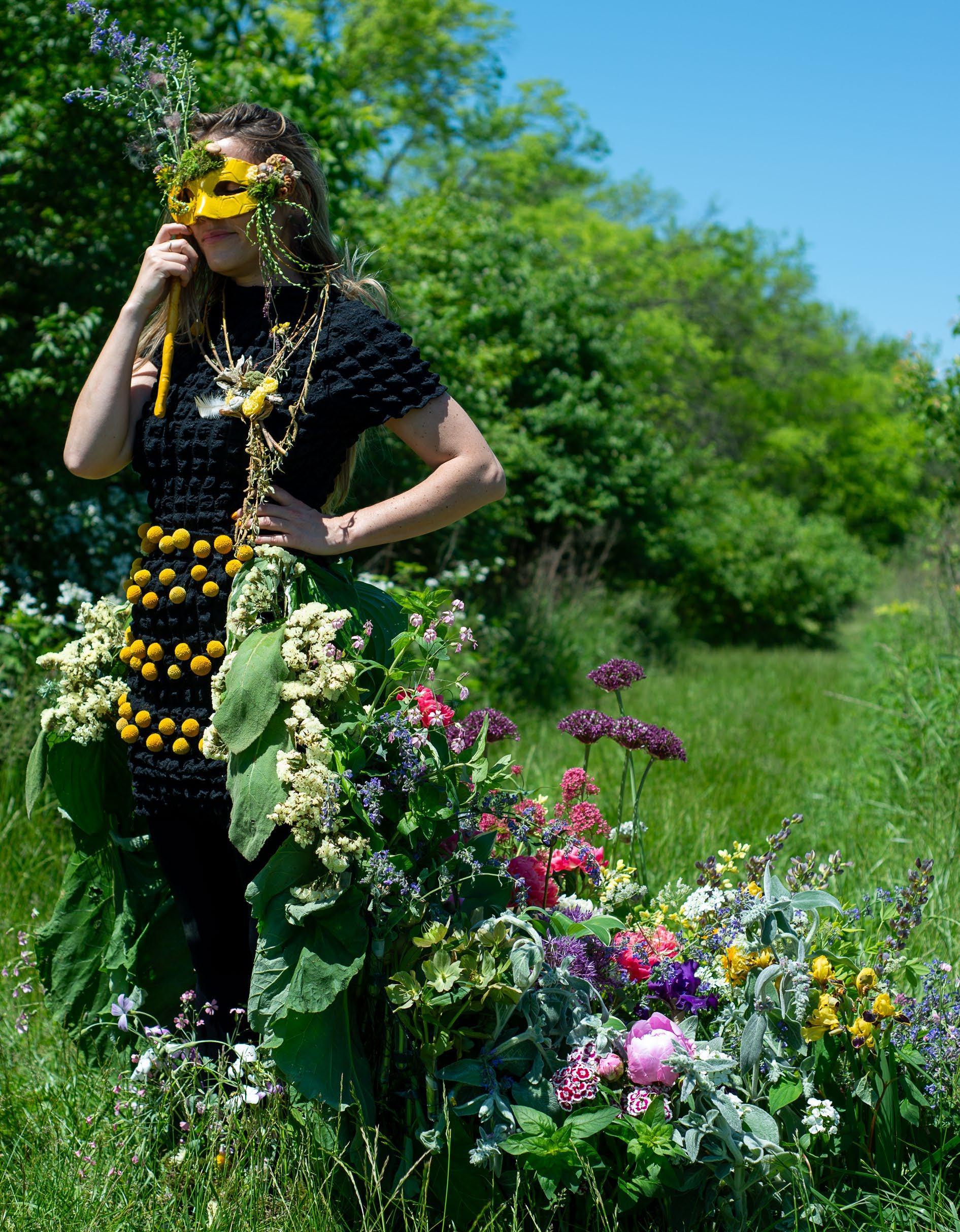
DESIGN + CONCEPT: Blair Lynn, Sweet Blossoms, www.sweetblossomsllc.com, @thesweetblossoms FLOWER SOURCES: Dahlias, Lisianthus, Marigolds, Celosia, Ostrich Fern, Snapdragons, Hydrangea, Grateful Gardeners, @grateful_gardeners; Hydrangea blooms and foliage, Sweet Blossoms, @thesweetblossoms
PHOTOGRAPHY: Kirsten Smith Photography, @kirstensmithphotography MODEL: Tanya Ferrell
HAIR + MAKEUP: Tanya Ferrell VENUE: Grateful Gardeners Farm, Poolesville, Maryland, @grateful_gardeners
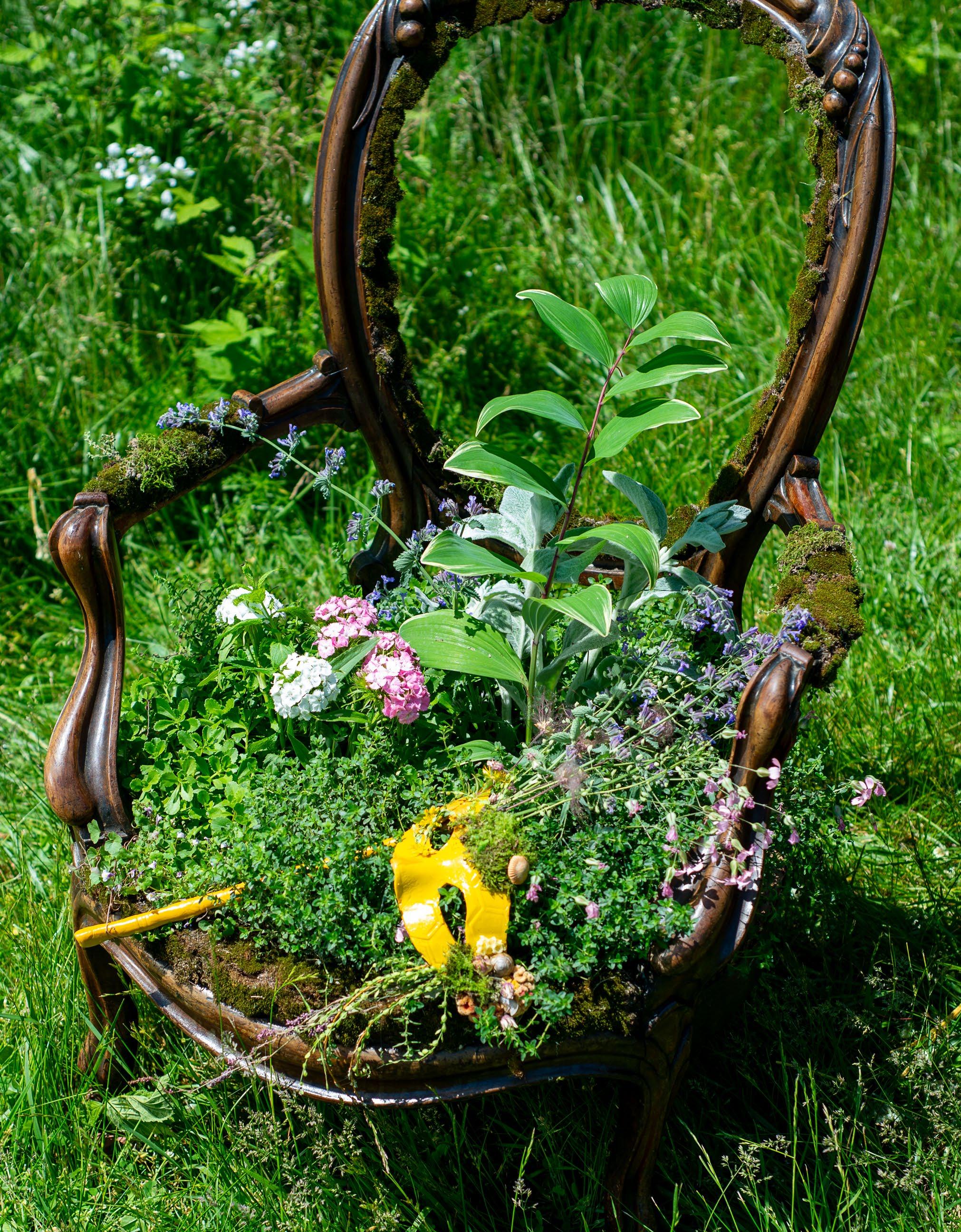
DESIGN
BY
LINDA SPRADLIN, IN THE GARDEN FLOWER FARM, SEVEN MILE, OHIO
PHOTOGRAPHY BY
ZACHARY SPRADLIN
of hosta foliage and other greenery. “I wanted my garment to be fresh and seasonal,” Linda pointed out. “I didn’t want to use anything that wasn’t growing at that moment.”
White statice accentuates the skirt’s front openings, emulating ruffle trim, while threaded Craspedia (Billy ball) drapes across the model’s torso as strands of oversized beads. Rhubarb leaves, harvested from the garden of Nan Matteson of Queen City Flower Farm—Linda’s past botanical couture collaborator—line the underskirt to provide a soft finish that protects the model’s legs from scratchy chicken wire.
There’s something about the natural world, and this botanical couture garment is a way for me to be in the natural world and be creative.
The garment is styled with Linda’s take on “slow jewelry,” a necklace created from willow saplings and foraged bark and feathers, with honeycomb pieces contributed from a local beekeeper. For the photo shoot, a task assigned to Linda’s son Zachary, the “prop” is a planted Victorian parlor chair. Where tufted velvet once cushioned the seat, there’s now a planting of moss, herbs, and spring perennials. “It’s definitely a growing chair,” she joked.
Linda sees herself as a “maker” for whom the garden and flower fields are her favorite art supplies. “There’s something about the natural world, and this botanical couture garment is a way for me to be in the natural world and be creative.”
Later this summer, when customers visit In the Garden Flower Farm to harvest from Linda’s you-pick field, she will put the planted chair on display. “It will be adorable and perfect for photo ops!”
STORY BY JEN RICH, RICH EARTH DESIGNS
PHOTOGRAPHY BY
ELLE HYGGE
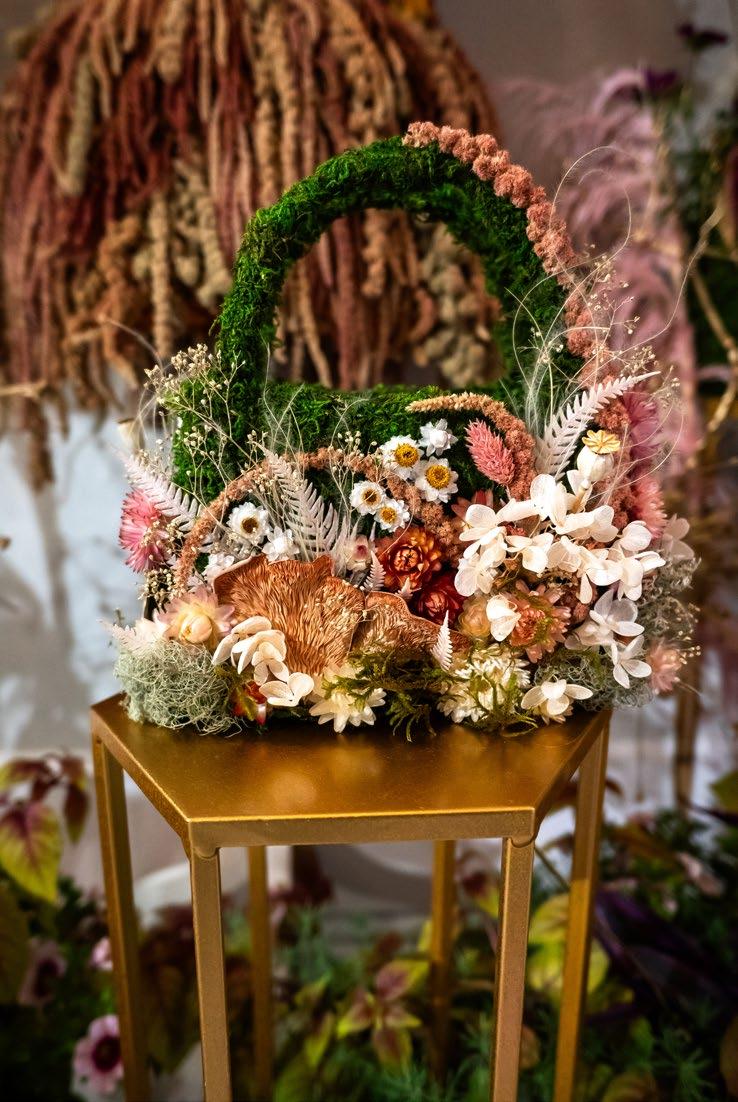
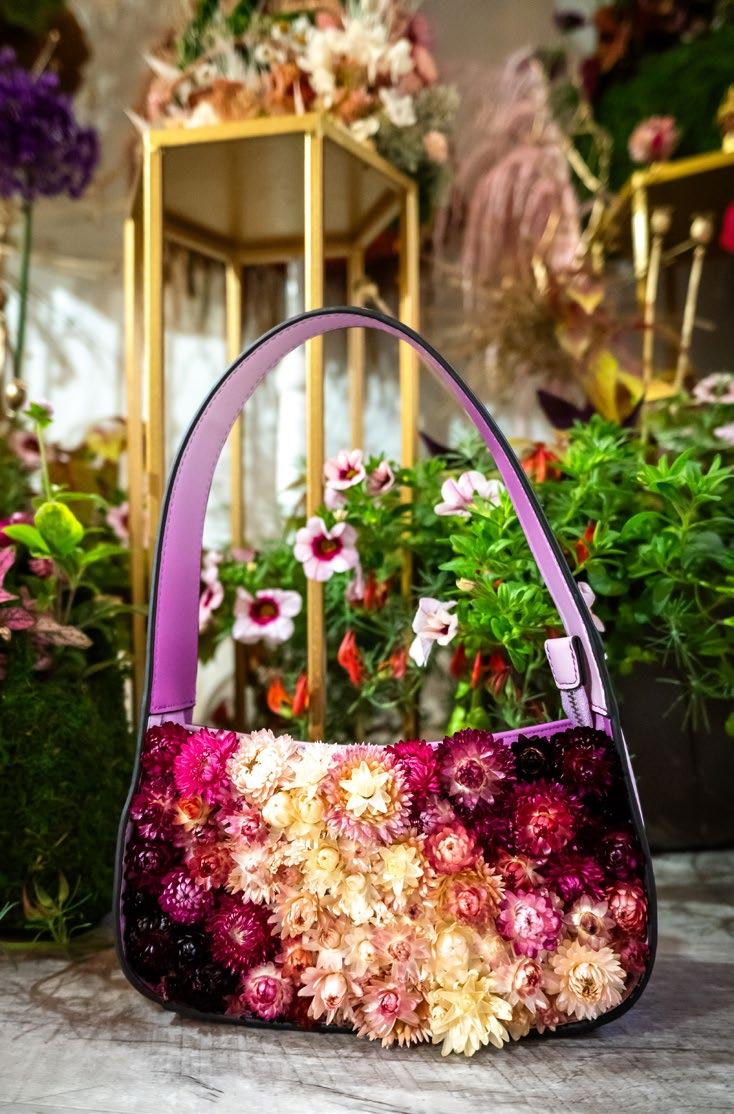
THE SECOND ANNUAL BLOOM TOUR IS PART WALKING tour and part art show with a focus on supporting some of Portland’s unique shops, restaurants, and hotels. The event ran from May 11 to June 11, showcasing the work of artists and florists who created 29 stunning, large-scale floral installations that were on display during Portland’s Rose Festival.
The Luxury Exchange, a reseller of luxury goods, was the perfect Bloom Tour collaborator, as I absolutely love combining flowers and fashion. I also enjoy growing and designing with dried flowers because they go the distance, don’t require water, and are often a more sustainable option.
A botanical couture dress was at the center of this installation, and featured a sweetheart bodice and mini-skirt created with dried strawflowers, amaranth blooms, poppy pods, and pink oyster mushrooms grown by a local farmer. The firework-like blooms are dried Allium schubertii flowers, a stunner in the garden and perfect for dried floral decor.
Because The Luxury Exchange has the most fabulous selection of designer handbags in the city, I was excited to recreate several floral handbags for the installation. You will also find a few rings in the mix. In creating these accessories, I was inspired by Portland floral artist Françoise Weeks, who taught me the foundations of wearable floral mechanics. She has helped me push the boundaries of where I take flowers today.
BloomTourisaprojectoftheVisitDowntownCampaign, a program run byDowntownPortland(Oregon)Clean&Safe,andthePortlandBusiness AlliancewithadditionalfundingfromtheCityofPortland.

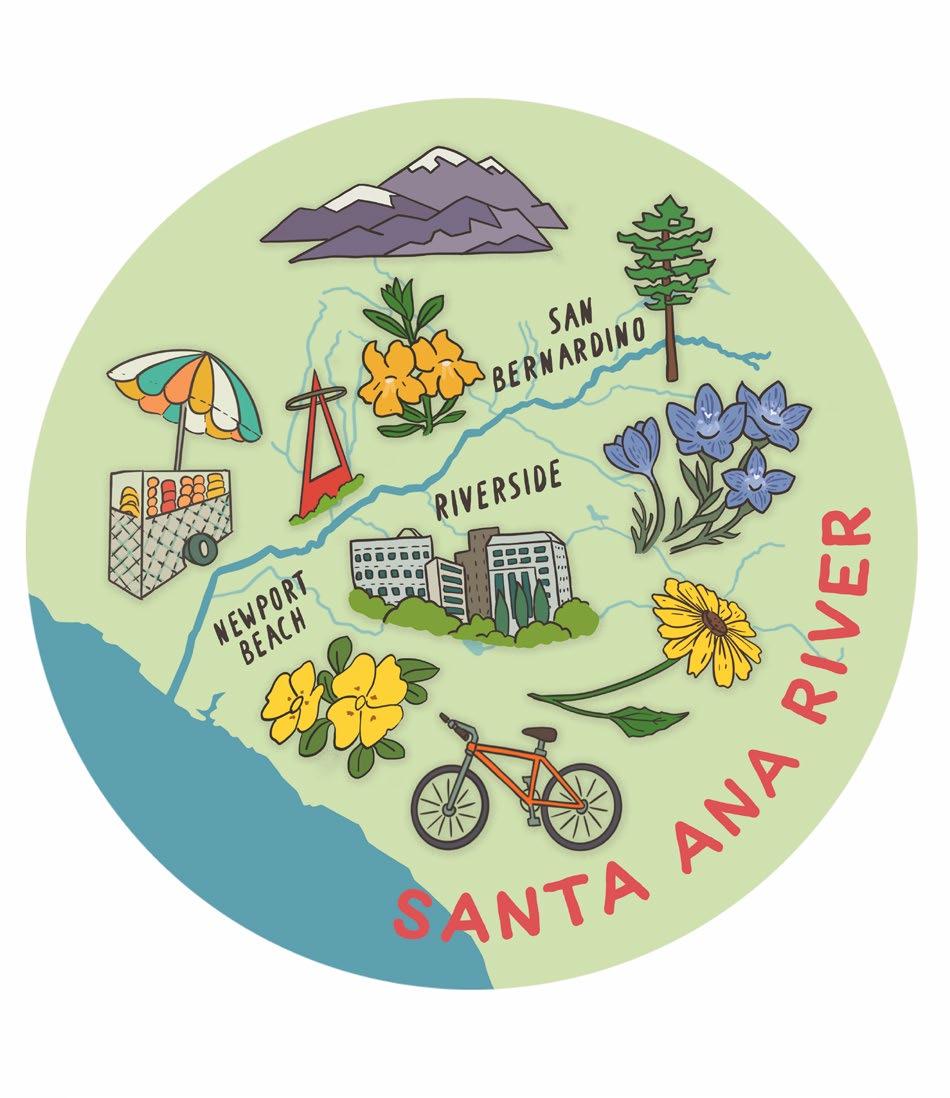
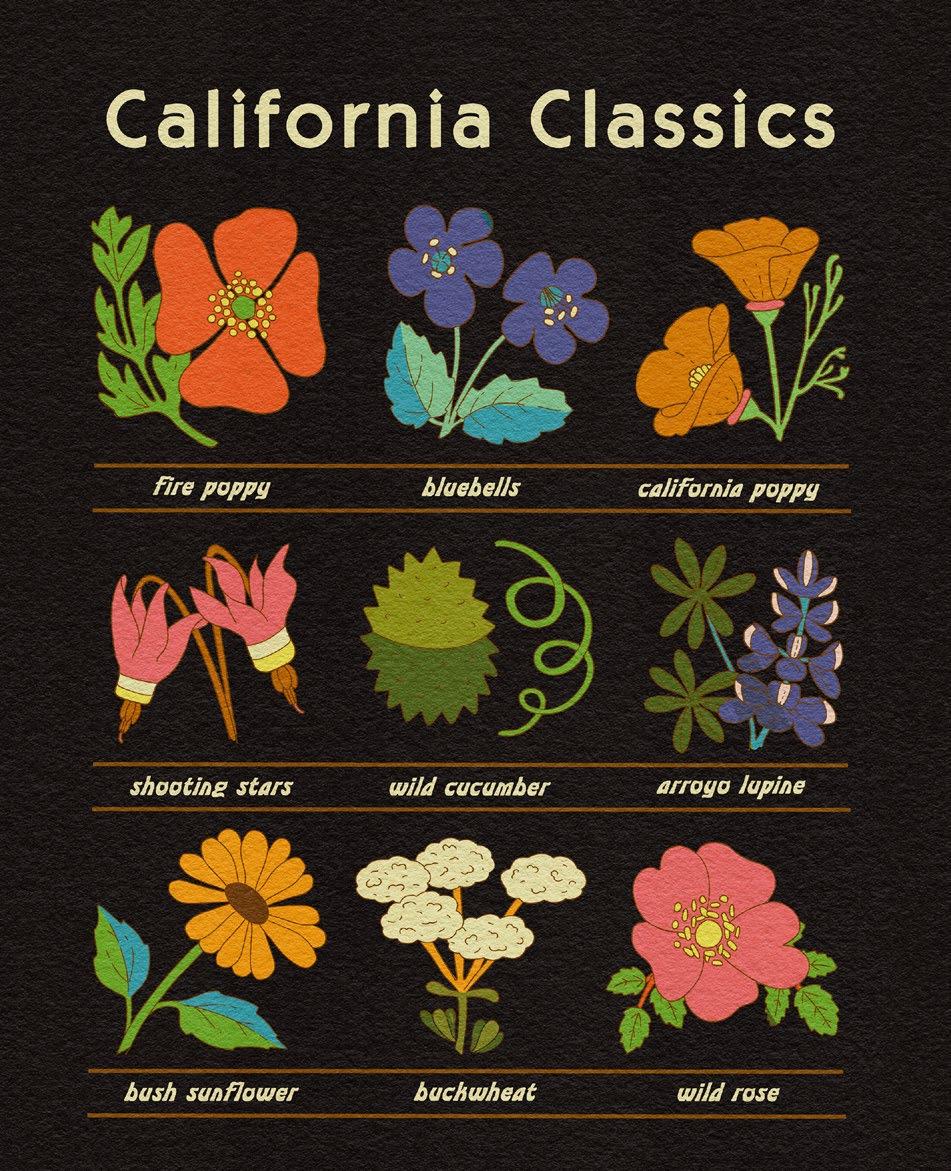
The 2024 American Flowers Week artwork was created exclusively for Slow Flowers Society by Lesley Goren, an illustrator and designer whose work focuses on the natural environment.
Lesley Goren is interested in "place," be it the woods, the city, or somewhere in between. Her work depicts the beauty of California's natural environments, and uses informational illustrations to explain plant life and fire ecology. She loves using images and text to make ideas more accessible, while her contemporary and lively drawings are scientifically accurate.
Lesley has shown and sold her work in galleries, boutiques, and park visitor centers throughout California and beyond. She creates custom illustrations for clients, especially in the environmental-based nonprofit sector. She also creates commissioned art for clients and collectors. Lesley resides in Ventura County, California.
We first connected with Lesley in 2021, after following her on social media and falling in love with her focus on native plants, wildlife, and ecology. It's taken a few years to pull things off, but we're thrilled that Lesley was available to create our 2024 original American Flowers Week illustration.
We love how Lesley thoughtfully researched native flowering annuals and perennials "across America," which supports one of our important insights for 2024. Click here for the full list of native plants featured in Lesley’s artwork.
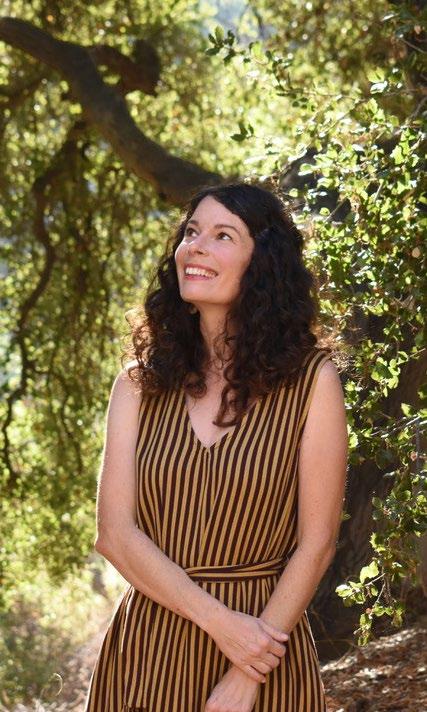
Recently, our founder Debra Prinzing connected with Lesley to discuss her story and her relationship with flowers and nature.
AFW: Lesley, can you describe how your studio started focusing on art inspired by nature?
LG: I found my niche working with native plants, but I was also doing logo design, surface design, and illustrations. I was doing so many different things, but over the past year, I have started saying “no” to many. It was a little scary, but it has been really good to do it. In the end, I feel that it’s better to be good and true at who and what you are.
AFW: What got you started down this path?
LG: I’ve always had art-related jobs, but I was usually someone’s assistant – architectural restoration, decorative painting, digital arts. After I became a mom, the idea was that I would go back to work when my children were both in school. I assumed I would find something similar to my past jobs, but I really wanted to start my own studio. My life was about the natural world, the environment, native plants, gardening, being out on the trails, so I decided to align my personal and ideological selves with my professional self –and it just clicked in a way that my work never had before.
AFW: What were some of your first projects?
LG: It started very small. I was printing my own cards and it got to the point where I’d be up at three in the morning trying to keep up with orders. I took lots of baby steps, like having the cards professional printed. Then people started hiring me for client projects. That pace has continued for the past five years.
AFW: Can you point to a specific project that shifted your focus to native plants?
LG: Yes, the California Native Plant Society contacted me two or three years ago. They needed a logo for their “Bloom California” campaign, which was aimed at getting more growers and
nurseries in California to grow native plants.
AFW: How do you approach your client commissions?
LG: Generally, unless a client has something very specific, the easiest way for me to start is to select the color palette. Once I have that, I’ll pick the plant species based on those colors. For example, right now, I’m working on something that includes blue, purple, orange, and creamy white. The design includes milkweed, poppies, goldfields, lupins, and baby blue eyes. I’ll then block out a composition based on those colors and research the flowers so I can make sure they’re scientifically accurate, even through the illustration is going to be stylized. Working with a mood board with reference images and colors, I’ll move on to the line drawings. From there, I’ll send a loose sketch and color palette to the client. Once we have those elements figured out, I start refining the drawing and basically, I “digitally paint” it.
AFW: When you say “sketch,” are you still using a pen or pencil, or can you do that digitally?
LG: I use Procreate, which is an illustration app on the iPad, and draw with an Apple pencil. Of course, it doesn’t feel like paper, because it’s a glass surface, but besides that, it’s very similar to
drawing on paper. It’s just a faster process. If a client asks me to move three flowers to the bottom of the illustration, it’s literally a twosecond change. For a hand-drawing, that would be a lot more work.
AFW: Do you miss hand-drawing?
LG: It’s super important to continue doing it – even if not for a client project. Hand-drawing keeps your skills sharp and fresh as an artist, so it will always be part of my practice, even if not for a specific design.
AFW: If you’re out on a hike, are you mainly using the camera on your phone to snap images of real wildflowers or do you take a little sketch pad with you?
LG: I draw the plants. I love drawing from nature even if it’s something no one else ever sees. It’s such a meditative process that teaches you a lot more about plants. There’s only so much you can see from a photo, but when you can get around a plant and see it from all angles, even smell its scent, you just have a different tactile experience with it.
AFW: You talk like a botanist! Have you researched and studied the plants you illustrate?
LG: Yes, I’m reading a lot and trying to go to in-person events that are led by botanists.
AFW: Do you consider yourself a botanical illustrator?
LG: It’s a little different. There
are so many people who draw similar plants that I draw, but they tend to have more of a traditional watercolor style, which is so beautiful. But I am setting out to do something a lot more designforward and contemporary. It would be meaningless if I didn’t have the science behind it, though.
AFW: Yes, your work feels very contemporary, but retro at the same time.
LG: Yes, I’m constantly looking at inspiration from the turn of the last century to the 1970s and 1980s. I love looking at old World War II posters and victory garden era images from the 1940s. I take different color palettes and bring them more into the contemporary environment.
AFW: Other than your American Flowers Week illustration, can you share some of your recent or current projects?
LG: Right now I’m working on an illustration for Los Angeles Times Plants’ digital feed. The project is about how “all blooms are super.” Another project is with a landscape architecture firm.
AFW: We’re excited to see those pieces! Let’s talk about your wallpaper designs, too!
LG: I’ve created wallpaper for the gallery space at Theodore Payne Foundation for Wild Flowers and Native Plants. It coordinated
with my display of small digital paintings. Also, I recently designed wallpaper for an architect that was installed in a beautiful Craftsman home.
AFW: What motivates you as an artist, Lesley?
LG: I’m sometimes asked, “What can you possibly do with the plants you’re drawing?” And I think my objective is just that you can’t have a connection to something if you don’t know it. Maybe someone will send one of my cards to a friend and the friend thinks it’s a cute drawing. But then, they turn it around and read the plant name, maybe even the Latin name. And the next time they’re out on the trail, they see the plant and recognize it.
AFW: Tell us about your own garden!
LG: When we moved here, the previous owner had made this unbelievable garden that I could tell was a passion project with about 40 roses. But as I’ve learned about gardening, over time, I started replacing those plants that were high-water-use with droughttolerant plants. With the help of Nicole Calhoun, of Artemisia Nursery in Los Angeles, we’ve converted the front of our house to native plants. And all these little baby natives now are taking off!

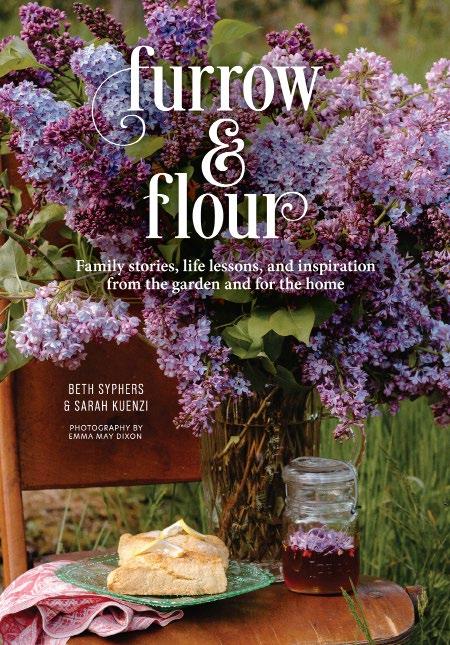
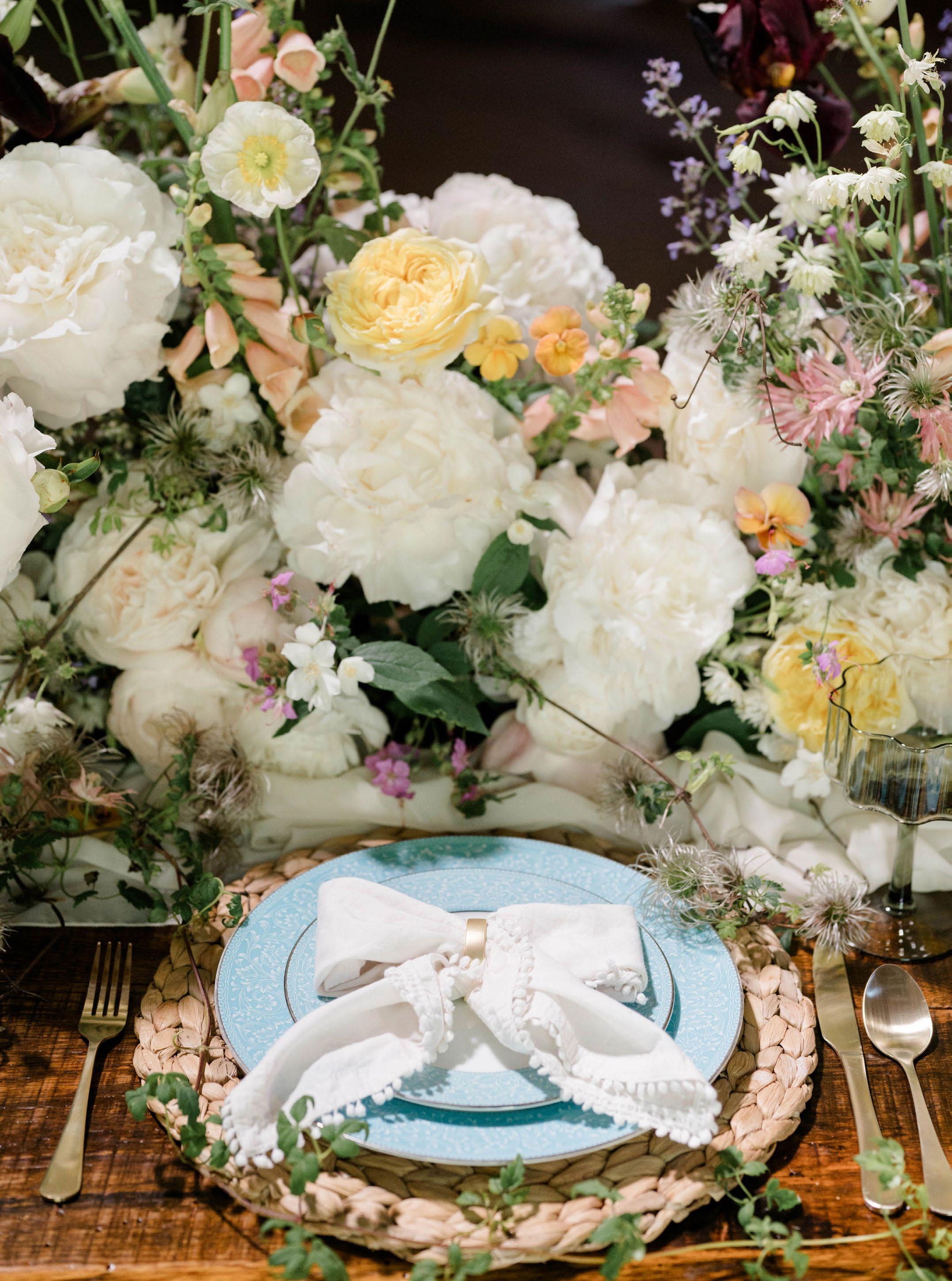
There’s something utterly freeing to be the creative on a styled shoot. Just ask Tara Folker of Splints & Daisies Floral Design. Based in Lancaster, Pennsylvania, the wedding and event florist is also a hobby grower, often harvesting blooms from her garden outside to add special elements to bouquets, arrangements, artistic installations, and photography projects.
“I don’t like the stress of a planned shoot, but I do love to be spontaneous when the opportunity arises,” Tara acknowledged.
The designer has created botanical couture looks for past American Flowers Week collections, bringing her dramatic floral styling to both womenswear (2017) and menswear (2023) pieces. She recently launched a new website, and in collecting galleries from her portfolio, Tara realized she wanted to show more complete tabletop designs with gorgeous centerpieces.
That need led to this tabletop design based on a bumper crop of white peonies and other late-spring blooms. When photographer Alyssa Bunton, who frequently acquires flowers from Splints & Daisies, mentioned her interest in photographing more floral work, Tara jumped at the chance.
“Alyssa is more ‘light and airy’ as a photographer – her work is very soft, but captures florals in true colors. I thought it would be a fun experiment to have a ‘light and airy’ photographer in my dark and moody barn,” she explained.
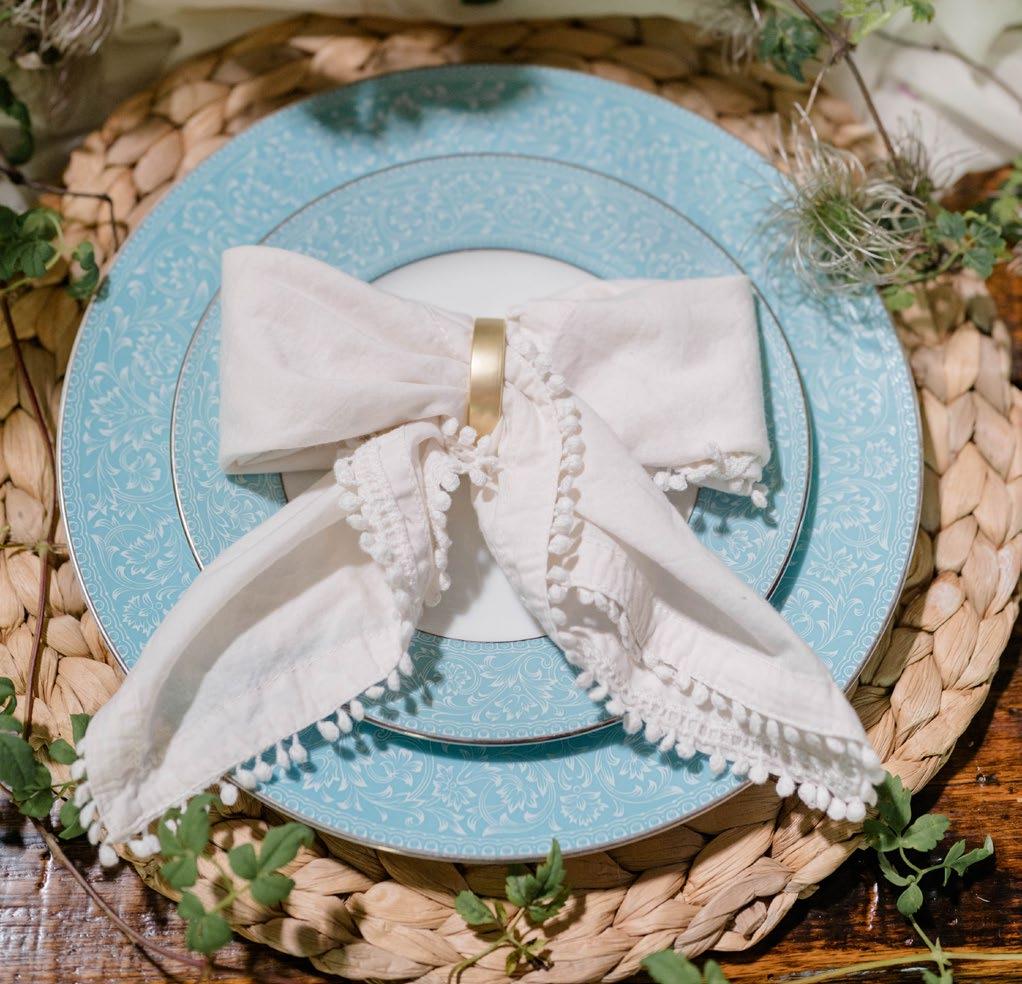


The shadowy setting gains dramatic contrast when “you open the barn door and the light pours in,” Tara noted. The farm table and natural woven chargers harmonize with the barn’s rustic setting and provide textural contrast for vintage china, stemware, and flatware.
The flower-focused design deemphasizes a pair of low ceramic dishes that hold identical sideby-side arrangements. Tara’s mechanics are simply chicken wire and water. The vessels contain stems from a soft profusion of peonies, garden roses, bearded irises, poppies, foxgloves, alliums,
geums, pansies, mock orange branches, clematis vines and seedheads, and the lavender-hued flowers of pelargonium and nepeta.
In addition to cutting from her Splints & Daisies garden, Tara sourced stems from two other area farms: Cool Spring Gardens and Riverside Blooms. Like a tangle from the cottage borders, Tara’s whiteand-pastel floral palette requires close attention to identify its elements. Tiny blooms and curious seedheads accentuate the bolder focal flowers, while clematis tendrils escape from the centerpieces to encircle a set of robin’s egg-blue
dishes, originally from Tara’s great grandmother’s china cupboard. It’s as if the garden grew onto the table and began to trail through its place settings.
The locally made beeswax candles and handblown stemware are borrowed from both Tara’s and the photographer’s collections. “This is not a formal tabletop. It’s more of an artistic one, which leaves room for eclectic elements,” Tara said. “We both loved how this
WEBSITE INSTAGRAM
Slow Flowers Podcast Episodes (January to June 2024)
EPISODE 646 | JANUARY 24, 2024
Secrets of a Sustainable Wedding Florist with Jessica Stewart of Pittsburgh's Bramble & Blossom
WATCH HERE
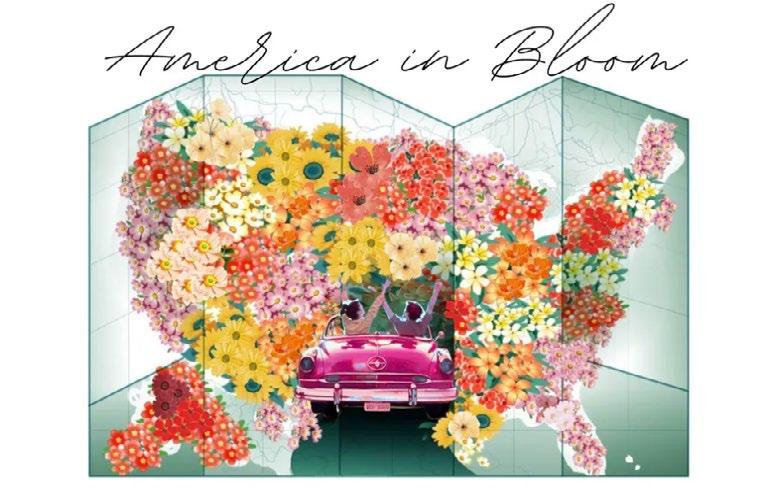
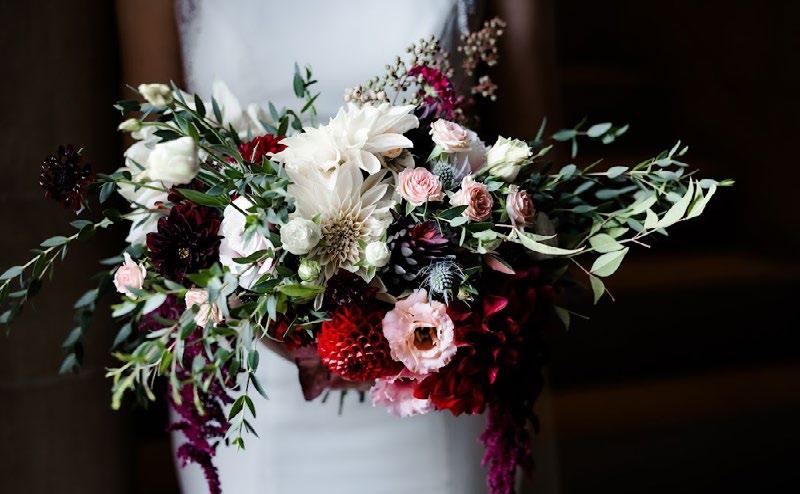
EPISODE 649 | FEBRUARY 14, 2024
Flowers as Art: Botanical Couture and Floral Installations with Jennifer Reed of Jennifer Designs.
WATCH HERE
EPISODE 655 | MARCH 27, 2024
A visit to Françoise Weeks' studio and a peek into her new book, "Wonder of the Woodlands”.
WATCH HERE

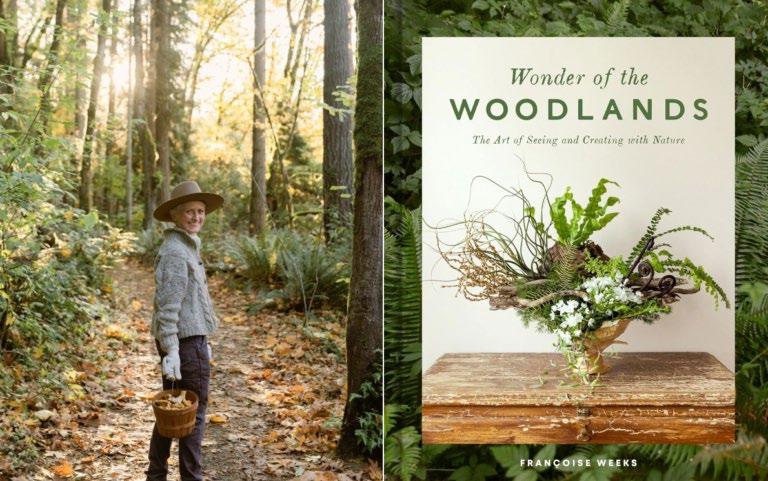
EPISODE 659 | APRIL 24, 2024
Designer Leslie Bennett, co-author of "Garden Wonderland” and founder of Pine House Edible Gardens and Black Sanctuary Gardens.
WATCH HERE
EPISODE 660 | MAY 1, 2024
Flower Farming in Los Angeles: Meet a trio of growers behind an upcoming flower farm tour on the unique character of urban flower farming in Southern California.
WATCH HERE
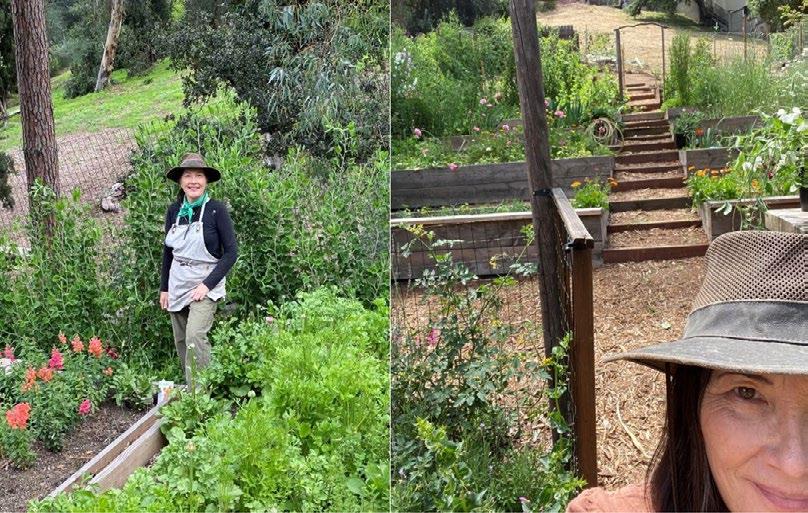
Since 2021, Slow Flowers Society has sponsored cut-flower questions included in the National Gardening Survey, a study of more than 2,500 households in the U.S. We expanded the 2024 survey questions to ask consumers about the reasons they purchase local and domestic cut flowers and floral arrangements, as well as their awareness of the sources of their floral purchases.
Launched in 1973, the National Gardening Association provides in-depth and up-to-date marketing information on industry trends, household participation, consumer profiles, gardeners' attitudes, and retail sales in the lawn and garden industries. The 2024 National Gardening Survey provides valuable insights into American household lawn and garden activities and spending for the year 2023, as well as expectations for 2024.
Anecdotally, we know that consumers are more conscious than ever about “doing well” with their purchases.
For 2024, respondents cited the top reasons they purchased locally grown or American-grown cut flowers or arrangements:
66%
Helping family-owned flower farms to keep jobs in my region
60%
Backing my community’s economic growth
51%
Protecting the floral agriculture industry in my region
49%
Supporting a diversity of flower choices and sources in the marketplace
38%
Minimizing the carbon footprint of moving perishable products like flowers
33%
Preserving rare and valuable flower varieties
2% Other
When asked where the cut flowers and flower arrangements purchased in 2023 were grown, respondents said:
49%
Local flower farms in my region or state
20%
Flower farms in the United States outside of my region
40%
Unsure; I don’t know where the flowers I purchased were grown
6%
Flower farms in other countries
Prior National Garden Surveys (2022-2023) asked consumers how important it is to them to buy local and domestic flowers and floral arrangements:
65%
Say that it is very or somewhat important that the flowers they purchase are locally grown (up from 58% in 2021)
61%
Say that it is very or somewhat important that the flowers they purchase are American-grown (up from 57% in 2021)
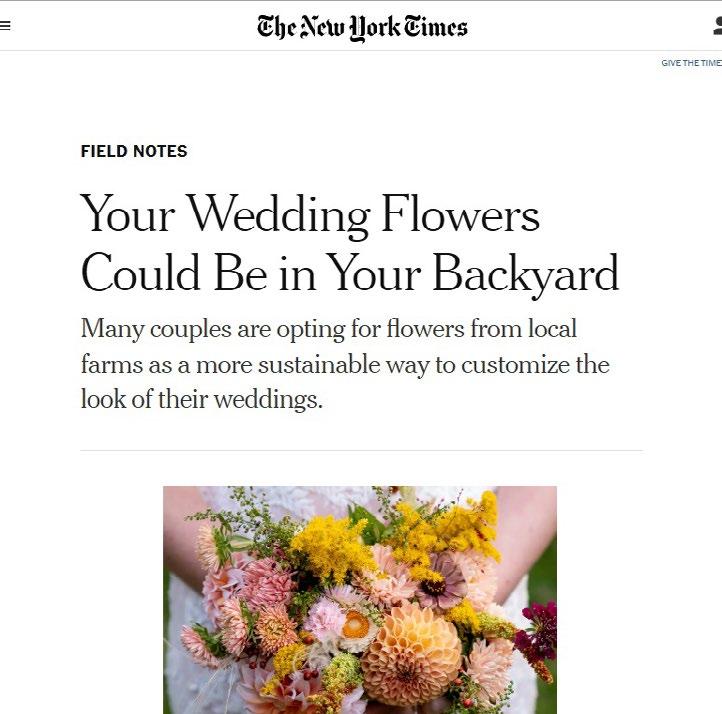
JUNE 27, 2024 | New York Times
“Ms. Prinzing attributes the rising interest in local flora partly to social media, where couples and florists have shared photos of romantic bouquets featuring non-conventional flowers.”
READ MORE

APRIL 22, 2024 | INC.
“Slow Flowers has given her access to a community of farmers, florists, designers, and other floral business professionals.”
READ MORE

MAY 9, 2024 | National Geographic
"The Slow Flower Movement fosters a closer connection between consumers and the floral landscape, inspiring a renewed appreciation for the beauty and diversity of locally grown flowers.”
READ MORE
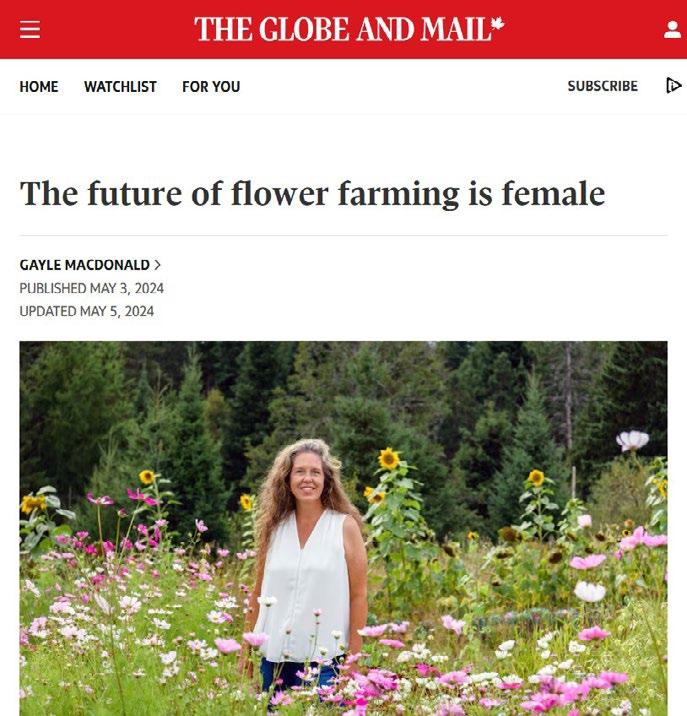
MAY 9, 2024 | Globe and Mail
“For a long time, women who wanted to work with flowers became florists. ...Then in the early 2010s, the Slow Flowers Movement – a philosophy similar to the slow food movement, encouraging consumers to purchase stems grown locally, seasonally and ethically –started to gain momentum.”
READ MORE
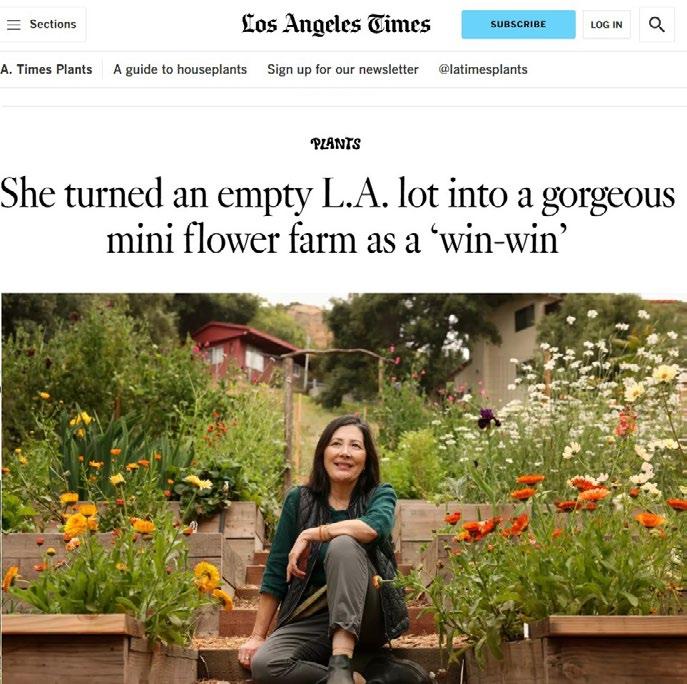
MAY 22, 2024 | Los Angeles Times
“I think people want to engage more deeply with nature as an antidote to the general stress and chaos of life.”
READ MORE
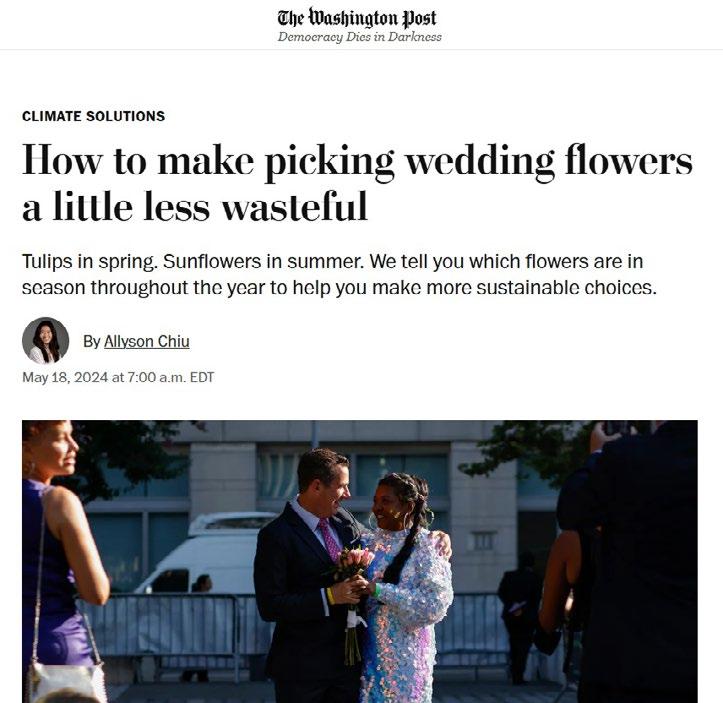
MAY 18, 2024 | Washington Post
“We want our farmers to make a living wage, and we should consider other factors besides price alone, including freshness and quality of locally grown flowers.”
READ MORE
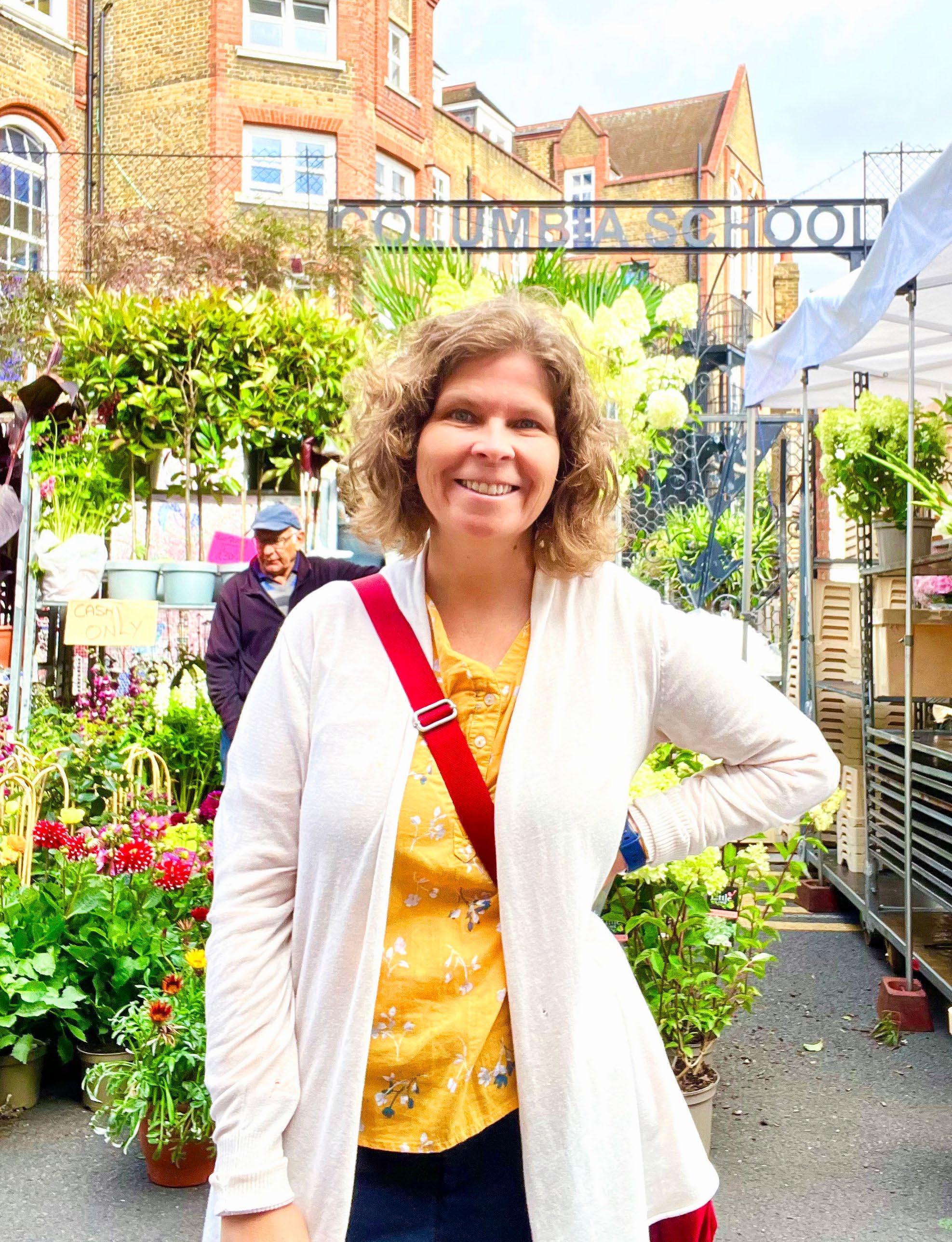
I was working part-time on a vegetable farm and selling at farmers’ markets when I first read “Flower Confidential” in 2007. My experience on the farm, at the markets, and reading that book changed my life. I loved everything about the work and the market community. It was a reprieve from my boring day job in a stuffy office, and the produce we grew brought people together every week.
In business school at the time, I was determined to become a small business owner for my second act. Amy Stewart’s exposé on the global flower industry was the inspiration for my next career. My plan was to start a wedding floral business that only sourced locally grown flowers as a more sustainable alternative to conventional florists.
Super excited about this idea! I would continue to work with farmers. I could serve a community I had grown to embrace. I defined a unique value proposition in the mid-Atlantic, and planned to offer a service missing in my market. Back in 2007, there were so few opportunities for wedding couples in our area to connect with local growers to buy event flowers. There was interest, particularly among the farmers’ market community, to buy local, be sustainable, and make purchases that were environmentally responsible. Despite my feasibility study and business plan raising a few red flags – a paucity of flower farmers in my region, comparatively higher prices for locally grown flowers, and cost identified as the top consideration for flower buyers – I was determined to make this idea work.
Local Color Flowers opened in 2008 (based from my house) as a part-time wedding floral design business sourcing 100 percent locally grown flowers. There were five farmers who reluctantly sold me some of their superfluous inventory at wholesale pricing. I didn’t have a big need, and they thought my local-only model was a fad that wouldn't last more than one season. I only booked six weddings my first year, but I had grand plans. I wanted to be a full-time florist with my own shop, booking more weddings, teaching design classes,

fulfilling corporate contracts, delivering single orders, and more! I knew from my farmers’ market experience that I could build a small community of devoted true fans. If I was going to grow this business, though, I needed more local flowers. And by the looks of my five grandpa growers, I needed younger farmers.
Growing growers became part of my business mission. I offered two incentives: a no-interest micro-loan program for new flower farmers, and a promise to buy a grower’s entire first-year harvest (and sometimes second and third). I also started recruiting. I pitched flower growing at vegetable-farmer meetings. (I actually converted
a few.) As I realized my business aspirations, I even hired several of my start-up growers to work part-time at my shop while they developed their farms. Gradually, the number of farms that sold to me grew and offered more diverse and interesting blooms. Some became specialists, like my peony and rose growers. Customer awareness was also building, and there was specific demand for locally grown flowers.
I started to find I wasn’t alone slinging local flowers. There were a few of us around the country. Pre-social media, I found and followed a few farmer-florist blogs. I joined the ASCFG in 2009 when there were only about 500 members. In the mid-Atlantic, Future Harvest's Beginner Farmer
Training Program also started that year with the mission of developing a younger farming workforce in the Chesapeake Bay area. (Although it took a few years, flower farming later became part of their curriculum.) The Maryland Cut Flower Growers Association had been around for years with just a handful of members but was starting to add new farmers at that time. Momentum was building. Local flowers were a thing.
When social media blew up, especially Instagram, I discovered a bigger, and international, sustainable flowers movement. While Slow Flowers told the story of North American flower farms, I discovered many leaders in floral

sustainability around the world. Becky Feasby from Prairie Girl Flowers in Canada was bringing attention to invasive species and reducing their use in design. Rita Feldmann, from Australia, founded The Sustainable Floristry Network. The biggest impact came from England, where modern floristry has its roots. Shane Connelly, the Royal’s florist, showed that local flowers can be elevated and showcased for even the most highprofile events.
The local flower industry is growing and thriving today. The ASCFG has close to 3,000 members now, and the Maryland Cut Flower Growers Association is approaching 300 farmers. Some
of the growers who benefitted from my loan program and buying promise are also flourishing. They have diversified their sales outlets and no longer depend on me as their only customer. Some of my employees have moved on to start their own businesses, one even taking my single-order subscriptions with her as I downsized. The plan worked! Those young farmers and shop staff are launched, and I’m working on new things in my late-career. Now, I’m focusing on spreading the local love by writing a weekly newsletter, recording videos, speaking, teaching, and building a community of flower nerds online.
The vast majority of flowers sold in the U.S. will continue to be grown
overseas. That’s also the case in Canada, Australia (to a lesser degree), and England. Flower farming in many of the highexport countries provides income where jobs are scarce. The rise of locally grown flowers, however, is undeniable. The movement can put pressure on the international trade to become healthier and more equitable. Flowers have creative, positive power when they are slow, sustainable, and local. They give me purpose, develop viable businesses, educate customers and create community. I love local flowers.
Slow Flowers aims to reconnect flower consumers and floral professionals with the source of their flowers. We believe that when the origin of all botanical varieties sold to consumers and florists is clearly labeled, we place higher value on local, seasonal, and sustainably grown florals, used artistically to express beauty.
1. To recognize and respect the seasons by celebrating and designing with flowers when they naturally bloom.
2. To reduce the transportation footprint of flowers and foliage by sourcing as locally as possible.
3. To support flower farmers small and large by crediting them when possible through proper labeling at the wholesale and consumer level.
4. To encourage sustainable and organic farming practices that respect people and the environment.
5. To proactively pursue equity. inclusion. and representation in the floral marketplace. intentionally valuing Black floral professionals and farmers. floral designers, and vendors of color in our business practices with as much support as we give to environmental sustainability.
6. To eliminate waste and the use of chemical products in the floral industry.
The Slow Flowers Movement puts a priority on sourcing local and domestic flowers In a way, this also means that we redefine beauty. As a Slow Food chef cooks with what is seasonally available, a Slow Flowers florist designs with what is seasonally available.
